George Town, Penang
| George Town | |||
|---|---|---|---|
| City and State Capital | |||
| Penang Island | |||
| Other transcription(s) | |||
| • Malay | Tanjung Penaga | ||
| • Chinese | 乔治市 | ||
| • Tamil | ஜோர்ஜ் டவுன் | ||
|
Clockwise from top right: Penang Bridge, Eastern & Oriental Hotel, St. George's Church, George Town skyline and Queen Victoria Memorial Clock Tower. | |||
| |||
|
Nickname(s): Mutiara Timur Pearl of the Orient[1] | |||
 Location in Penang | |||
 George Town Location within Peninsular Malaysia | |||
| Coordinates: 5°25′00″N 100°19′00″E / 5.41667°N 100.31667°ECoordinates: 5°25′00″N 100°19′00″E / 5.41667°N 100.31667°E | |||
| Country |
| ||
| State |
| ||
| Founded | 11 August 1786 | ||
| Municipality established | 1857 | ||
| Granted city status | 1 January 1957[2] | ||
| Government | |||
| • Mayor | Patahiyah Ismail | ||
| Area[3] | |||
| • City and State Capital | 122.79 km2 (47.41 sq mi) | ||
| • Metro | 2,740.000 km2 (1,057.920 sq mi) | ||
| Elevation[4] | 14 m (46 ft) | ||
| Population (2010) | |||
| • City and State Capital | 708,000[5] | ||
| • Metro | 2.5 million | ||
| Time zone | MST (UTC+8) | ||
| • Summer (DST) | Not observed (UTC) | ||
| Postal code |
100xx to 108xx 111xx to 118xx | ||
| Area code(s) | +604 | ||
| Vehicle registration | P | ||
| Website |
mbpp | ||
George Town, the capital city of the Malaysian state of Penang, is situated at the north-eastern tip of Penang Island. Its urban population is estimated at 708,000, while the Greater Penang conurbation has a population of 2.5 million, making George Town and Greater Penang the second largest city and the second most populated metropolitan area in Malaysia respectively.[6][7][8][9] One of the oldest cities in Malaysia, George Town was inscribed as a UNESCO World Heritage Site along with Malacca City in 2008.
Established by Captain Francis Light of the British East India Company in 1786, George Town was one of the first British settlements in South-East Asia. Together with Singapore and Malacca, George Town was governed under the Straits Settlements, which later became a British crown colony in 1867. It was subjugated by the Empire of Japan during World War II, before being recaptured by the British at war's end. Shortly before Malaya attained independence from the British Empire in 1957, George Town was declared a city by Queen Elizabeth II, the first in the country's modern history. In 2015, Penang Island, on which George Town is located, also obtained city status.
Due to the intermingling of the various ethnicities and religions that arrived on its shores during its heyday as a British entrepôt, George Town acquired a large assortment of colonial and Asian eclectic architectural styles, which led to its inscription as a UNESCO World Heritage Site in 2008.[10] It also gained a reputation as Malaysia's gastronomic capital, due to its unique and ubiquitous street food.[11][12][13][14] Moreover, the city hosts intangible cultural heritage, such as that of the Peranakan (formerly known as the Straits Chinese), a hybrid ethnicity which has left its mark on Penang's architecture and cuisine.
Additionally, George Town is Malaysia's most vital medical tourism hub, receiving approximately half of Malaysia's medical tourists, many from neighbouring countries such as Indonesia and Singapore.[15][16][17] It also serves as the financial hub within the north of Malaysia, with numerous Malaysian and foreign banks setting up branches in the city.
Logistically, George Town is a well-connected city, with the Penang International Airport 14 km to the south linking it to several major cities in the region including Kuala Lumpur, Singapore, Bangkok, Taipei and Hong Kong. An enduring legacy from the British colonial era is the Port of Penang, which still serves the northern region of Malaysia by connecting George Town with over 200 ports worldwide.[18][19] George Town is also connected to the rest of Peninsular Malaysia via a ferry service and the Penang Bridge.
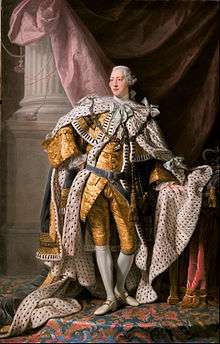
Etymology
George Town was named after King George III, who was the reigning British monarch when Captain Francis Light first set foot on Penang Island in 1786.
The promontory where George Town is now located was once known as Tanjung (Malay: cape).[20] The name was derived from the older name of the place, Tanjung Penaga (Cape Penaigre).[21]
History
Founding of George Town
As the Dutch East India Company had dominated the Far East spice trade by controlling the East Indies, the British East India Company requested Captain Francis Light to establish trade relations in the Malay Peninsula.[22] Faced with Dutch dominance in the region and a growing French threat, the Company sought control of Penang Island as a Royal Navy repair base and a trading post between China and the Indian subcontinent.[23][24]
Light subsequently landed on Penang Island on 17 July 1786. Later, Fort Cornwallis was erected at the spot where Light first set foot. For Light, Penang Island was a "convenient magazine for trade", and served as a strategic location to check Dutch and French territorial gains in South-east Asia.[25]
At the time, Penang Island was part of the Kedah Sultanate, which was threatened with imminent Siamese and Burmese invasions.[26] Taking advantage of the situation, Light negotiated with Sultan Abdullah Mukarram Shah of Kedah regarding the cession of Penang Island to the British East India Company, in exchange for British military protection.[24]
After an agreement was sealed between Light and the Sultan, Light returned to Penang Island on 11 August. Upon his arrival, the Union Jack was raised, signifying the formal possession of the island by the British East India Company "in the name of His Britannic Majesty, King George III". Penang Island was renamed the Prince of Wales Island after the heir to the British throne, while the new settlement of George Town was created in honour of King George III.[27]
The new settlement of George Town was built out of a swamp. As Fort Cornwallis was being constructed, Light encouraged immigrants to the new settlement by firing silver coins into the jungles.[24] He also introduced George Town as a free port, enticing traders from Dutch ports in the region.[28] The number of incoming vessels rose from 85 in 1786 to 3,569 in 1802; George Town's population had also increased to 10,000 by 1792.[29][30][31]

In its early years, George Town was developed in a haphazard manner, as buildings and streets were created on an ad hoc basis.[32][33] The new settlement was bounded by four streets - Light Street, Beach Street, Chulia Street and Pitt Street.[34] The segregation of George Town's commercial and administrative centres, as well as ethnic enclaves, can still be seen to this day; banks and warehouses were arranged along George Town's financial heart at Beach Street, whereas administrative and judicial buildings are concentrated around Light Street, which functions as a government precinct.[35]
Captain Francis Light died from malaria in 1794 and was buried within the Old Protestant cemetery at Northam Road (now Jalan Sultan Ahmad Shah). To this day, Light is honoured as the founding father of Penang.
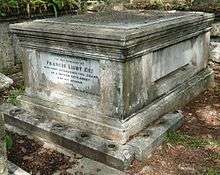
A committee of assessors was established in 1800. It was the first local council to be established in British Malaya.
Colonial Era
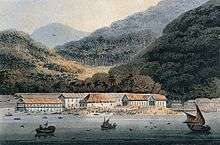
In 1826, George Town was made the capital of the Straits Settlements, an administrative polity that was also composed of Singapore and Malacca. However, the capital was then shifted to Singapore in 1832, as the Port of Singapore was more strategically located along the India-China naval route and had already surpassed George Town as the preeminent harbour in the region.[36]
Nonetheless, George Town continued to retain a secondary importance to Singapore.[37][38] The booming spice trade had led to the opening of spice farms all over Penang Island, making the island a centre of spice production in South-east Asia; the export of spices also allowed the Company to cover the administrative costs of Penang.[39][40] Apart from funnelling the exports meant for global shipping lines which had bypassed other regional ports, the tin mining boom in neighbouring Perak towards the end of the 19th. century transformed the Port of Penang into a major tin-exporting port in the Malay Peninsula, directly challenging the Port of Singapore.[41][42]
The rapid population growth stemming from economic development created problems such as sanitation, inadequate urban infrastructure, transportation and public health. Main roads were extended from George Town into the spice farms further inland, leading to the gradual expansion of George Town. But to sate the severe labour shortages in public works, the government began the practice of employing Indian convict workers as low-cost labourers. Most worked on the streets of George Town, draining swamps and clearing forests, constructing drainage ditches, and laying pipeworks for clean water. Indeed, convict labour was key to Penang's successful colonisation as many found employment in the civil service, military, and even as private servants to the colonial officials and private individuals.
For ten days in August 1867, George Town was gripped with civil unrest during what was known as the Penang Riot which pitted rival secret societies Kean Teik Tong (Tua Pek Kong Hoey), led by Khoo Thean Teik and the Red Flag against the alliance of the Ghee Hin Kongsi and the White Flag. The British authorities under newly appointed Lieutenant-Governor Col. Edward Anson quelled the rioting with sepoy reinforcement after days of chaos.
Also in the same year, the Straits Settlements was made a British crown colony, thereby transferring the administration of Penang, Singapore and Malacca from the hands of the British East India Company into the Colonial Office in London. For George Town, direct British rule meant better enforcement of the rule of law, as Penang's police force was vastly improved and the secret societies that had plagued George Town during the preceding decades were gradually outlawed.[37][43]
At the turn of the century, George Town, with her large population of Chinese immigrants, was a natural place for the Chinese nationalist Sun Yat-sen to raise funds for his revolutionary efforts in Qing China. These frequent visits culminated in the famous 1910 Penang conference which paved the way to the ultimately triumphant Wuchang uprising that overthrew the Manchu government.
World Wars
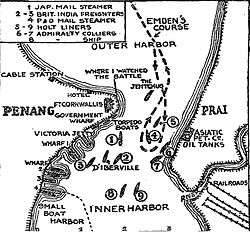
At the start of World War I in 1914, SMS Emden, an Imperial German Navy cruiser, sank two Allied warships off the coast of George Town, in what would become known as the Battle of Penang. 147 French and Russian sailors lost their lives, while the others were rescued by local Malay fishermen.[44]
World War II, on the other hand, brought unparalleled social and political upheaval to Penang. Between 9 and 18 December 1941, Japanese warplanes indiscriminately strafed and bombed George Town, as well as wiping out the outdated Royal Air Force and Royal Australian Air Force squadrons defending Penang.[47][48] It was estimated that 600 civilians perished as a result of the Japanese bombardment, with an additional 1,100 wounded.
Eighty Japanese fighters and bombers had flown over Georgetown unopposed... Thousands of people had filled the streets to watch the spectacle, which turned to tragedy when the bombs began to fall. Aircraft had then wheeled down to dive-bomb and strafe. Mass panic was the result of the bombing, and Penang had no anti-aircraft guns and few air raid shelters. Most of the bombs fell by design on Georgetown's densely populated Chinatown...[49]— Allen Warren, British historian.
While the British Army had earlier designated Penang Island as a fortress, Lieutenant-General Arthur Percival then ordered a withdrawal from Penang. Not only did the British Army abandon the Batu Maung Fort at the south-eastern tip of Penang Island, they also covertly evacuate Penang's European population, leaving the rest of Penang's populace to their fates.[50] Historians have since argued that the withdrawal and the silent evacuation of the white race led to the loss of the British sense of invincibility, and that "the moral collapse of British rule in Southeast Asia came not at Singapore, but at Penang".[51]

George Town fell to the Imperial Japanese Army on 19 December 1941, marking the start of a brutal period of Japanese occupation.[47][52] Penang Island was renamed Tojo-to, after the then Japanese Prime Minister Hideki Tojo.[51] This period was renowned for the Imperial Japanese Army's massacres of Penang's Chinese populace, also known as Sook Ching to the locals.[53] Especially feared was the Japanese military police Kempeitai and its network of informants. Women in George Town were also coerced to work as comfort women by the Imperial Japanese Army.
Another little known aspect of the Japanese occupation was the use of George Town's harbour facilities as a major U-boat base by Nazi Germany.[54][55] Between 1942 and 1944, the Port of Penang was utilised by submarines of the Imperial Japanese Navy, the Kriegsmarine and the Regia Marina (of the Kingdom of Italy).[56][57][58]
Between 1944 and 1945, Royal Air Force and United States Army Air Force bomber squadrons based in British India repeatedly bombed George Town, seeking to destroy the naval facilities and administrative centres.[47] The destruction of the Penang Secretariat building by the Allied bombardment caused the loss of the greater part of the British and Japanese records concerning Penang Island, leading to enormous difficulties to compile a comprehensive history of Penang.[59] The Penang Strait was also mined to impede Japanese shipping.[60]

.jpg)
Following the Japanese surrender on 15 August 1945, the Penang Shimbun published on 21 August the proclamation of surrender issued by the Emperor of Japan. Under Operation Zipper, the British Royal Marines accepted the surrender of the Japanese garrison in Penang and retook Penang Island on 3 September 1945.
Post-War
After a period of military administration, the British dissolved the Straits Settlements in 1946 and proposed to merge the crown colonies of Penang and Malacca into the Malayan Union; Singapore was to be excluded and governed as a separate crown colony. The Malayan Union was ultimately replaced with the Federation of Malaya in 1948.
At the time, the idea of the absorption of the British colony of Penang into the vast Malay heartland alarmed Penang's population over economic and ethnic concerns.[61] The Penang Secessionist Movement (active from 1948 to 1951) was formed to preclude Penang's merger with Malaya, but a secession motion tabled in the Penang Settlement Council in 1949 was narrowly defeated by British official votes.[62][63][64] Another petition sent to London also met with British disapproval in 1951. The movement was spearheaded by, among others, the Penang Chinese Chamber of Commerce, the Penang Indian Chamber of Commerce, and the Penang Clerical and Administrative Staff Union.[65]
The British government responded to the concerns raised by the Penang Secessionist Movement by guaranteeing George Town's free port status, as well as reintroducing municipal elections in George Town in 1951.[62] By 1956, George Town had become the first municipality in the Federation of Malaya to have a fully elected local council.
On 1 January 1957, George Town was declared a city by Queen Elizabeth II, becoming the first city in the Federation of Malaya. George Town continued to be the only city within Malaysia (other than Singapore between 1963 and 1965) until 1972, when Kuala Lumpur was granted city status.
Post-Independence
In the following years, George Town retained its free port status, as guaranteed by the British colonial authorities before granting independence to the Federation of Malaya. This was not to last, however - in 1969, the Malaysian federal government revoked George Town's free port status, sparking massive unemployment in the city.[35][63][66] The economic downturn was only alleviated with the development of the town of Bayan Lepas to the south as a Free Industrial Zone by the then Chief Minister of Penang Lim Chong Eu.
On the other hand, this also marked the start of George Town's decline, which lasted up to the 2000s.[67] As the Malaysian federal government continued to develop Kuala Lumpur and nearby Port Klang by controlling investments in communication, transport, education and health, Penang began to suffer considerable brain drain as younger Penangites started emigrating for better employment opportunities.[35][68][69][70][71][72] In 1976, the George Town City Council was merged with the Penang Rural District Council to form the Penang Island Municipal Council, sparking a decades-long debate over George Town's city status.[73][74][75][76]
In a bid to revitalise George Town, the Komtar project was launched in 1974. Hundreds of shophouses, schools and temples, as well as whole streets, were erased from the map in order to make way for the construction of Penang's tallest skyscraper.[35] However, instead of arresting George Town's decline, Komtar itself became a white elephant by the 2000s.[77][78][79][80]
Renaissance
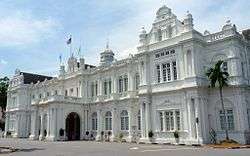
The pre-War houses in the historic centre of George Town was for half a century until January 2001 protected from urban development due to the Rent Control Act which prohibited landlords from arbitrarily raising rentals as a measure to provide affordable housing to the low-income population.[81] Its eventual repeal visibly changed the landscape of Penang's demographic pattern and economic activity: it led to overnight appreciation of house and real estate prices, forcing out tenants of multiple generations out of their homes to the city outskirts and the development of new townships and hitherto sparsely populated areas of Penang; the demolition of many pre-War houses and the mushrooming of high-rise residences and office buildings; and the emptying out and dilapidation of many areas in the city centre. Unperturbed development sparked concerns of the continued existence of heritage buildings and Penang's collection of pre-War houses (Southeast Asia's largest), leading to more vigorous conservation efforts.
In 2008, George Town was inscribed as a UNESCO World Heritage Site along with Malacca. It was a recognition of the conservation efforts of the "unique architectural and cultural townscape without parallel anywhere in East and Southeast Asia".[10][82] The subsequent cleaning up of George Town and other measures to improve traffic flow, pedestrianisation, cultural and environmental aspects by the newly elected Pakatan Rakyat state government also led to George Town being ranked the 8th most liveable city in Asia by ECA International in 2010.[83][84][85][86][87][88][89]
The Indian Ocean tsunami which struck on Boxing Day of 2004 hit the western and northern coasts of Penang Island, including George Town, claiming 52 lives (out of 68 in Malaysia).
Whilst George Town had been declared a city by Queen Elizabeth II in 1957, Penang Island as a whole was also granted city status by the Malaysian federal government in 2015.[90]
Geography
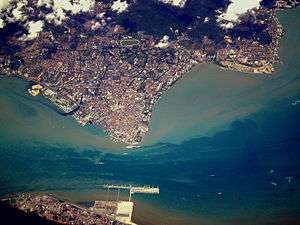
As Penang Island is only slightly ⅓ the size of Singapore with a population density of 2,559.7 square km,[91] George Town has the highest population density of all Malaysian cities.[92] From a small settlement at the north-eastern tip of Penang Island, George Town has expanded in all directions, eventually linking up with the industrial town of Bayan Lepas at the south-eastern part of Penang Island. and in the process, urbanising the entire eastern coast of the island.
The contiguous hotel and resort belts of Batu Ferringhi and Tanjung Bungah and Tanjung Tokong along the northern beaches of Penang Island also form the north-western edges of George Town.
The central hills of Penang Island, including Penang Hill, serve as a giant green lung for George Town and an important forested catchment area. While the central hills have somewhat limited the westward urban sprawl, the expansion of George Town is more evident southward along the eastern seaboard of Penang Island, creating the suburbs of Jelutong and Gelugor; the latter merging with the northward development of Bayan Lepas.
As with most island cities, land scarcity is a pressing issue on Penang Island. Land reclamation projects have been carried out to provide more low-lying land in high-demand areas, such as at Karpal Singh Drive, Gurney Drive and Tanjung Tokong.
Cityscape


| Malacca and George Town, Historic Cities of the Straits of Malacca | |
|---|---|
| Name as inscribed on the World Heritage List | |
.svg.png) | |
| Location | Malaysia |
| Type | Cultural |
| Criteria | ii, iii, iv |
| Reference | 1223 |
| UNESCO region | Asia-Pacific |
| Inscription history | |
| Inscription | 2008 (32nd Session) |
UNESCO World Heritage Site
The oldest portion of the city centre has been designated by UNESCO as a World Heritage Site since 2008.[93] Recognised as having a 'unique architectural and cultural townscape without parallel anywhere in East and Southeast Asia', George Town contains the largest collection of pre-World War II buildings in Southeast Asia and is considered an architectural gem.[82]
The World Heritage Site covers about 260 hectares of the city centre, roughly bounded by Transfer Road to the west and Prangin Road to the south. The World Heritage Site is further divided into two - the core and buffer zones. The core zone includes the oldest quarter of George Town, where the most historic landmarks like Fort Cornwallis, City Hall, Penang State Museum and the bank headquarters along Beach Street are located. This particular area dates all the way back to the settlement's establishment by Captain Francis Light in 1786, thereby predating most cities within Peninsular Malaysia and Singapore.
The core zone is surrounded by the buffer zone, which is delineated along George Town's 19th century boundaries. Chinese shophouses, Hindu temples, Indian Muslim mosques and two of the city's oldest wet markets are located within this zone, as are Cheong Fatt Tze Mansion and the Eastern & Oriental Hotel.
Among the many restrictions in force within both zones is a ban on the construction of any structure exceeding 18 metres in height.
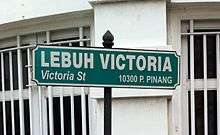
Street Names
Unlike other cities in Malaysia, George Town still retains most of its English street names. Even for roads that have been renamed in Malay, such as Jalan Masjid Negeri, Penangites in general still prefer to use the road's former colonial name, which in this particular case is Green Lane. This is partly because the new names are often unwieldy (e.g. Pitt Street vs Jalan Masjid Kapitan Keling, Northam Road vs Jalan Sultan Ahmad Shah), but also reflects a strong conservatism in the local population, who see Penang's colonial history as part of their local identity.
In addition, since 2008, Penang's multi-lingual road signs have been in use throughout Penang Island. Each of the new road signs has the street's official Malay name and either the street's English, Chinese, Tamil or Arabic name.[94][95][96] To this day, George Town is the only city in Peninsular Malaysia to have multi-lingual road signs.
Suburbs
%2C_Penang.png)
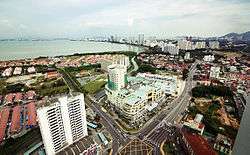
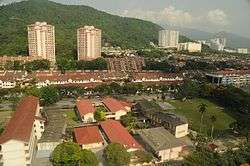
The expansion of George Town has created suburbs to its north-west, west and south. The north-western suburbs are somewhat more affluent, given their seafront locations which attract tourists and expatriates. The southern suburbs, such as Jelutong, grew due to industrial activities.[97] On the other hand, Air Itam and Paya Terubong emerged to the west of George Town as a result of agricultural plantations on the central hills of Penang Island.
The suburbs are listed as follows.
Beaches and Seafronts

The most popular beaches of George Town are situated along the city's north-western suburbs, specifically Batu Ferringhi, Tanjung Bungah and Tanjung Tokong. Several hotels and resorts have been established along these locations, including Hard Rock Hotel.
Other than that, the most famous promenades in George Town are Gurney Drive, the Esplanade and Karpal Singh Drive. Gurney Drive is also said to have the most developed skyline due to the skyscrapers and high-rises, and is a shopping haven with two upmarket shopping malls - Gurney Plaza and Gurney Paragon.
As of 2016, land reclamation is ongoing off Gurney Drive in an effort to turn the promenade into a major public park, named Gurney Wharf.
Hills
The central hills of Penang Island, situated to the west of George Town, serve as a gigantic green lung and water catchment area for the urbanised island.
Penang Hill, the tallest peak on Penang Island, lies near the centre of the island and west of Air Itam. The peak, 735 meters above sea level, is accessible via the Penang Hill Railway from its base station off Hill Railway Road at Air Itam. Once a retreat used by British officials and Queen Elizabeth II, the peak of Penang Hill is one of Penang's most well-known tourist attractions, with 1.36 million tourist arrivals in 2014.[98][99]
Parks
The main park within George Town is the Penang Botanic Gardens, located off Waterfall Road to the west of Pulau Tikus. Founded in 1884 as an offshoot of the Singapore Botanic Gardens, the Penang Botanic Gardens is Malaysia's oldest botanical garden. Today, it serves as the city's green lung and a major recreational area, receiving about 5,000 visitors every weekend.[100] The gardens also encompasses a youth recreational park and Penang's biggest waterfall, which contributes between 10% to 15% of Penang Island's water supply.[101]
Several other smaller parks dot the entire city, serving the surrounding neighbourhoods. These include the Armenian Street Park, TPO Friendship Park, Penang Graffiti Park and Relau Metropolitan Park.[102][103][104][105]
Drainage System
Major rivers within George Town include the Pinang River, Air Itam River and Gelugor River. Two dams - Teluk Bahang and Air Itam dams - store a considerable amount of George Town's water supply. About 10% to 15% of Penang Island's water supply is sourced from the Penang Botanic Gardens Waterfall.
Prangin Canal is a disused canal running eastward through Komtar in the heart of George Town towards the Penang Strait. It was once used by small vessels to transport agricultural produce from the hills around Air Itam downstream, as well as goods from cargo ships docked ashore. Today, it serves as nothing more than a drain.[106]
Climate
The city features a tropical rainforest climate, under the Köppen climate classification (Af). As it is the norm for Malaysian cities with this climate, George Town experiences relatively consistent temperatures throughout the course of the year, with an average high temperature of about 32 °C (90 °F) and an average low of 21 °C (70 °F).[107] Its driest months are from December through February. The city sees on average around 2,477 millimetres (97.5 in) of precipitation annually with the lowest being 60 millimetres (2.4 in) in February while the highest was around 210 millimetres (8.3 in) between August and October.[108]
George Town's proximity to the island of Sumatra, Indonesia makes it susceptible to dust particles carried by wind from the perennial but transient forest fires, creating a yearly phenomenon known as the Southeast Asian haze.[109] The haze season typically hits between July and October.
Weather forecasts in George Town is served by the Bayan Lepas Regional Meteorological Office, which acts as the primary weather forecast facility for northern Peninsular Malaysia.
| Climate data for George Town (Bayan Lepas) | |||||||||||||
|---|---|---|---|---|---|---|---|---|---|---|---|---|---|
| Month | Jan | Feb | Mar | Apr | May | Jun | Jul | Aug | Sep | Oct | Nov | Dec | Year |
| Record high °C (°F) | 35.2 (95.4) |
34.7 (94.5) |
36.0 (96.8) |
36.0 (96.8) |
36.0 (96.8) |
33.8 (92.8) |
33.8 (92.8) |
32.9 (91.2) |
33.0 (91.4) |
34.0 (93.2) |
34.0 (93.2) |
34.0 (93.2) |
36.0 (96.8) |
| Average high °C (°F) | 31.6 (88.9) |
32.2 (90) |
32.2 (90) |
31.9 (89.4) |
31.6 (88.9) |
31.4 (88.5) |
31.0 (87.8) |
30.9 (87.6) |
30.4 (86.7) |
30.4 (86.7) |
30.7 (87.3) |
31.1 (88) |
31.3 (88.3) |
| Daily mean °C (°F) | 26.9 (80.4) |
27.4 (81.3) |
27.6 (81.7) |
27.7 (81.9) |
27.6 (81.7) |
27.3 (81.1) |
26.9 (80.4) |
26.8 (80.2) |
26.5 (79.7) |
26.4 (79.5) |
26.5 (79.7) |
26.7 (80.1) |
27.0 (80.6) |
| Average low °C (°F) | 23.2 (73.8) |
23.5 (74.3) |
23.7 (74.7) |
24.1 (75.4) |
24.2 (75.6) |
23.8 (74.8) |
23.4 (74.1) |
23.4 (74.1) |
23.2 (73.8) |
23.3 (73.9) |
23.3 (73.9) |
23.4 (74.1) |
23.5 (74.3) |
| Record low °C (°F) | 19.0 (66.2) |
18.0 (64.4) |
20.5 (68.9) |
22.0 (71.6) |
20.5 (68.9) |
20.0 (68) |
20.0 (68) |
21.0 (69.8) |
20.0 (68) |
20.5 (68.9) |
19.5 (67.1) |
19.5 (67.1) |
18.0 (64.4) |
| Average rainfall mm (inches) | 68.7 (2.705) |
71.7 (2.823) |
146.4 (5.764) |
220.5 (8.681) |
203.4 (8.008) |
178.0 (7.008) |
192.1 (7.563) |
242.4 (9.543) |
356.1 (14.02) |
383.0 (15.079) |
231.8 (9.126) |
113.5 (4.469) |
2,407.6 (94.787) |
| Average rainy days (≥ 1.0 mm) | 9 | 9 | 14 | 19 | 19 | 15 | 17 | 18 | 24 | 24 | 22 | 15 | 205 |
| Average relative humidity (%) | 75 | 78 | 81 | 84 | 85 | 84 | 84 | 85 | 86 | 87 | 85 | 78 | 83 |
| Mean monthly sunshine hours | 248.8 | 233.2 | 235.3 | 224.5 | 203.6 | 202.4 | 205.5 | 188.8 | 161.0 | 170.2 | 182.1 | 209.0 | 2,464.4 |
| Source #1: NOAA[110] | |||||||||||||
| Source #2: Deutscher Wetterdienst (extremes and humidity)[111] | |||||||||||||
Government and Politics
Local Government
Local administration of George Town and all of Penang Island is carried out by the Penang Island City Council, an agency under the Penang state government. With a history dating back to 1800, it is the oldest local council in Malaysia and the successor to the nation's first city council - the George Town City Council.
Headquartered in the City Hall, the city council is responsible for urban planning, heritage preservation, public health, sanitation, waste management, traffic management, environmental protection, building control, social and economic development, and general maintenance of urban infrastructure.
The Mayor is appointed by the Penang state government every two years, while each of the 24 councillors is appointed for a one-year term.[112] The current Mayor of Penang Island is Patahiyah Ismail, who took office in 2015.[113]
Penang State Government

In the unicameral Penang State Legislative Assembly, George Town is represented by 13 state constituencies. The assemblymen and -women are elected into office via the Penang-level election, which by convention is held simultaneously with the Malaysian General Election every five years.
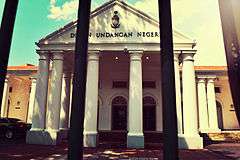
Since the 2013 Election, the elected assemblymen and -women in George Town are as listed below.
| State Seat | Assemblyman | Party |
|---|---|---|
| Tanjong Bunga (N22) | Teh Yee Cheu | DAP |
| Air Puteh (N23) | Lim Guan Eng | DAP |
| Kebun Bunga (N24) | Cheah Kah Peng | PKR |
| Pulau Tikus (N25) | Yap Soo Huey | DAP |
| Padang Kota (N26) | Chow Kon Yeow | DAP |
| Pengkalan Kota (N27) | Lau Keng Ee | DAP |
| Komtar (N28) | Teh Lai Heng | DAP |
| Dato Keramat (N29) | Jagdeep Singh Deo | DAP |
| Sungai Pinang (N30) | Lim Siew Khim | DAP |
| Batu Lanchang (N31) | Law Heng Kiang | DAP |
| Seri Delima (N32) | RSN Rayer | DAP |
| Air Itam (N33) | Wong Hon Wai | DAP |
| Paya Terubong (N34) | Yeoh Soon Hin | DAP |
The Penang State Legislative Assembly meets inside the Penang State Assembly Building at Light Street, George Town. Built in the early 19th. century, the building once served as the central police station for George Town, before being converted for its current purposes in the 1960s.
In addition, as the capital of Penang, George Town also houses the office of the Chief Minister of Penang. The office is located at the 28th. floor inside Komtar tower, the tallest skyscraper in Penang.[114]
Federal Constituencies
George Town is represented by four Members of Parliament in the Parliament of Malaysia. The Members of Parliament are elected via the Malaysian General Election, which is held every five years.
Since the 2013 Malaysian General Election, the Members of Parliament representing George Town are as follows.
| Parliamentary Seat | Member of Parliament | Party |
|---|---|---|
| Bukit Bendera (P048) | Zairil Khir Johari | DAP |
| Tanjong (P049) | Ng Wei Aik | DAP |
| Jelutong (P050) | Jeff Ooi Chuan Aun | DAP |
| Bukit Gelugor (P051) | Ramkarpal Singh | DAP |
As the capital of Penang, George Town also hosts federal government agencies and departments. Most of the federal government offices are located within Bangunan Persekutuan (Federal Building) at Anson Road, while the Immigration Department of Malaysia and the Inland Revenue Board of Malaysia maintain their respective offices at Beach Street. The Royal Malaysian Customs has an office at China Street Ghaut.
Several nations have also set up or appointed consulates for George Town, befitting its status as an important Malaysian city.
Judiciary
The Malaysian legal system had its roots in George Town. In 1807, a Royal Charter was granted to Penang which provided for the establishment of a Supreme Court. This was followed by the appointment of the first Supreme Court judge designated as the Recorder.
The Supreme Court of Penang was first opened at Fort Cornwallis on 31 May 1808. The first Superior Court Judge in Malaya originated from Penang when Sir Edmond Stanley assumed office as the First Recorder (later, Judge) of the Supreme Court of Penang in 1808. The Supreme Court was then relocated a short distance away to Light Street, where the present building was built in the 1903.
The legal establishment in George Town was later progressively extended to the whole of British Malaya by 1951.[105] Post-independence, the Malaysian judiciary has become largely centralised. The courts in Penang consist of the Magistrates, Sessions, and the Supreme Court, which remains at Light Street to this day.
The Syariah court, at Jalan Batu Gantung, is a parallel court which hears matters concerning Islamic jurisprudence.
Demographics
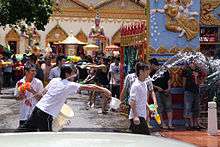
According to the 2010 census released by the Malaysian federal government, George Town had a population of 708,127. More recent estimates from the Penang Institute, a Penang-based think tank, indicated that 738,500 inhabitants lived within the city by 2012.[115] These figures placed George Town as Malaysia's second largest city by population.
In addition, approximately 2.5 million people live within the Greater Penang conurbation, which also covers Seberang Perai (the mainland portion of Penang) and the southernmost part of neighbouring Kedah. Thus, Greater Penang is the largest metropolitan area in Malaysia outside of Klang Valley (Greater Kuala Lumpur).
Past Records
By 1792, merely six years after the founding of George Town by Captain Francis Light, the new settlement had a population of about 10,000.[116] In the decades that followed, Chinese immigrants continued to flood into George Town, causing the Chinese population to outnumber the Malays by the 1850s.[7] George Town's population rose 101,182 by 1911 according to a census conducted by the Straits Settlements authorities.[7][117]
When George Town declined towards the end of the 20th. century, its urban population moved out into the suburbs, especially Air Itam, Gelugor, Tanjung Bungah and Tanjung Tokong. This was due to the rapid development of these residential suburbs, as well as the concurrent decline of the Port of Penang after the revocation of its free port status by the Malaysian federal government, which had resulted in massive unemployment and the dearth of economic opportunities in the city.[35][117] Younger Penangites began to migrate to Kuala Lumpur and further abroad for better employment opportunities. The decline in urban population, which lasted until the 2000s, was further aggravated by the repeal of the Rent Control Act, which forced tenants of shophouses in George Town to relocate to the suburbs.[118]
Ethnicities
While the breakdown of ethnicities in George Town has not always been recorded, statistics from Universiti Sains Malaysia showed that in 2010, the racial composition on Penang Island was about 45.8% Chinese and 36.8% Malay.[7] This was in addition to small Indian and Eurasian minorities. Most of the nearly 1,500 Eurasians, in particular, remain concentrated within Pulau Tikus.[119][120][121]
During the colonial era, apart from the Europeans, Eurasians and the already multiracial citizenry, there were communities of Siamese, Burmese, Filipino, Ceylonese, Japanese, Sumatran, Arab, Armenian, and Parsee people.[122] A small but commercially significant community of German merchants also existed in George Town.[123] Even though most of these communities are no longer extant, they lent their legacy to numerous street and place names such as the Burmese Buddhist Temple, Siam Road, Armenian Street and Gottlieb Road.

The Peranakan, descendants of mixed Malay and Chinese ancestries, had simultaneously lived throughout the Straits Settlements for generations. The Peranakan community in George Town, which included affluent members such as Chung Thye Phin, Lim Boon Keng and Khoo Sian Ewe, would go on to wield considerable influence in protecting Penang's commercial and political interests; the Penang Chinese Chamber of Commerce and the Penang Straits Chinese British Association were headed by Peranakans, and Penang was represented by members of this particular community in the Straits Settlements Legislative Council.[124] As the Peranakans tended to be more loyal to the British Crown than to China, they were also known as the King's Chinese. To this day, Peranakan influence is still visible in the form of Straits Chinese architectural styles and dishes like asam laksa.
There was also a Jewish enclave in George Town before World War II, but the Jewish community in George Town is believed to be all but extinct.[122][125][126]
George Town currently has a sizeable expatriate population, especially from Singapore, Japan and various Asian countries as well as the United Kingdom, many of whom chose to retire in Penang as part of the Malaysia My Second Home programme. In recent years, George Town has been acknowledged as one of the best cities to retire within South-East Asia, as reported by CNN and Forbes.[127][128]
Languages
As with other multi-ethnic cities in Malaysia, all four major languages are widely spoken in George Town - Malay, English, Chinese and Tamil. However, George Town, and by extension Penang, is best known for its distinct Hokkien dialect, known as Penang Hokkien.
During the British colonial era, English was the official language. This was helped by the mushrooming of missionary schools throughout George Town, including Penang Free School, St. Xavier's Institution, St. George's Girls' School, Catholic Convent schools and Methodist schools, all of which used English as their medium of instruction and were held in high esteem by the locals.[129] Most Penangites still maintain reasonable command of the language; while British English is formally used, spoken English usually takes the form of Manglish.[130] Notably, George Town is the only city in Malaysia that retains most of its English street names, as can be seen on the multi-lingual street signs in the city.
As with the rest of Malaysia, Malay is currently the official language in George Town. The Malays of George Town also use a unique dialect which is similar to Kedah Malay, with characteristic words such as hang, depa, pi and kupang. Syllables ending with aq are typically stressed.
Due to their Tamil ancestry, most Indians in George Town speak Tamil. Punjabi, Malayalam and Telugu are also spoken by smaller numbers of Indians.
Meanwhile, George Town's Chinese population uses a variety of Chinese dialects, reflective of their forebears' different places of origins in southern China. These include Hakka and Cantonese, while Mandarin, more widely used by youths, has been the medium of instruction in Chinese schools throughout Penang.
However, it is Penang Hokkien that serves as the lingua franca of George Town. Originally a variant of the Minnan dialect, over the centuries, Penang Hokkien has incorporated a large number of loanwords from Malay and English, yet another legacy of the Peranakan culture.[131] It is spoken by many Penangites regardless of race for communication purposes, so much so that even police officers also take courses in Penang Hokkien.[132][133][134] In recent years, steps are being taken to maintain the dialect's relevance in the face of increasing influence of Mandarin and English among the younger populace, including through books, dictionaries and movies.[135][136]
Economy
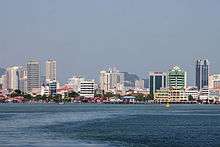
As the capital city of Penang, one of the most urbanised and industrialised states in Malaysia, George Town is one of the top contributors of Malaysia's Gross Domestic Product (GDP) and tax income.[137][138] Originally established as an entrepôt by the British, the economic sectors of George Town now vary from commerce to tourism.
George Town also acts as the economic pole of northern Malaysia, with relatively wide logistical connectivity. The Penang International Airport is one of the nation's busiest in terms of cargo tonnage and passenger traffic, while the Port of Penang remains the top entrepôt in northern Malaysia, handling the second largest total container throughput (TEU) among all Malaysian ports.[139]
In addition, Penang Island serves as the 'Silicon Valley of the East', as many multinational firms such as Dell, Intel, Motorola and Bosch have established electronic plants within the Bayan Lepas Free Industrial Zone to the south.[140] Massive industrialisation since the 1970s has led to manufacturing becoming one of Penang's top economic sectors, contributing as much as 47.4% of Penang's total GDP in 2015.[141]
Overall, Penang has the third largest economy of all Malaysian states, contributing as much as RM6.302 billion of Malaysia's tax income in 2014.[142][143] As of 2015, Penang's GDP per capita has risen to RM44,847, the highest among Malaysian states (excluding Kuala Lumpur).[144][145][146] Furthermore, Penang constantly records one of the lowest unemployment rates in the country - 1.5% in 2015.[147][148] Penang's Gini coefficient is also one of the nation's lowest, standing at 0.364 in 2014, which was lower than the national mean of 0.401.[149] In terms of foreign direct investment, Penang attracted nearly RM4.5 billion in 2015, the largest amount in Malaysia; this underlines Penang's potential as a favourite for foreign investors.[150][151]
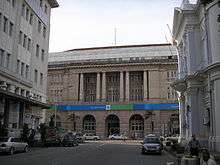
Commerce
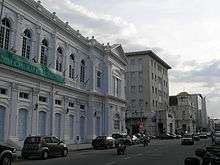
George Town was the centre of banking in Malaysia at a time when Kuala Lumpur was still a small outpost. The oldest bank in Malaysia, Standard Chartered Bank (then the Chartered Bank of India, Australia and China) opened its main branch in George Town in 1875 to cater to the financial requirements of early European traders.[152] This was followed by the Hongkong and Shanghai Banking Corporation (HSBC) in 1885 and the Royal Bank of Scotland (then ABN AMRO) in 1888.[140]
Today, George Town remains the banking hub of northern Malaysia, with branches of Citibank, United Overseas Bank, Oversea-Chinese Banking Corporation, Bank of China and Bank Negara Malaysia (Malaysian central bank) together with local banks such as Public Bank, Maybank, Ambank and CIMB Bank. Most of the older foreign banks still maintain their Penang headquarters at Beach Street, George Town's financial centre.
Tourism
George Town has always been one of the most popular tourist destinations in Malaysia. Throughout history, the city has even welcomed some of the most influential personalities, including Somerset Maugham, Rudyard Kipling, Noël Coward, Lee Kuan Yew and Queen Elizabeth II. In 2014, Penang attracted 6.84 million tourists.[153]
George Town's various attractions include the impressive array of heritage architecture, its multicultural society, a wide range of modern entertainment and retail choices, natural features such as beaches and verdant hills, and the world-famous Penang cuisine. The city's low cost of living and relatively well-developed infrastructure have also been cited as pull factors.[72]
In recent years, George Town has received numerous international accolades, further putting the city on the world stage. In 2016, George Town was recommended as one of the 16 must-see destinations by the Los Angeles Times, as well as one of the top ten by the Lonely Planet.[154][155] Forbes has also listed George Town as one of the best budget tourist destinations in 2016.[156] These are in addition to George Town's reputation as a gastronomic haven, with the CNN placing the city as one of Asia's best street food cities.[157]
Services
In recent years, the services sector, driven mainly by tourist arrivals into George Town, has become one of the top economic sectors in Penang. With nearly two thirds of Penang's workforce employed in services-related industries, this particular sector has also marginally overtaken manufacturing as Penang's biggest economic sector, contributing 48.6% of Penang's total GDP in 2015.[141]
Within Penang's services sector, the greatest number of employment was recorded in the retail, accommodation, and food and beverages (F&B) sub-sectors, clearly depicting the influence of tourist arrivals on service-related industries.
Penang's services sector is also boosted by shared services outsourcing (SSO) firms, including AirAsia, Citigroup and Temasek Holdings; the SSO sub-sector has raked in a yearly revenue of RM12.79 billion by 2013 and created over 8,000 jobs.[158][159]
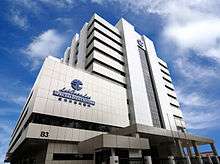
Medical Tourism
An integral part of Penang's services sector is medical tourism, which has made George Town the medical tourism hub of Malaysia. The city has attracted approximately half of Malaysia's medical tourist arrivals in 2013 and generated about 70% of the nation's medical tourism revenue.[16][17][72] About 1,000 patients arrive in George Town daily, mostly from Asian countries such as Indonesia, Singapore and Japan.
The success of George Town's medical tourism industry is mainly due to the specialised medical treatments offered at more affordable costs by the city's numerous private hospitals, coupled with well-trained professionals and advanced equipment.[72] Indirect factors that were cited include the relatively low cost of living, the laid-back lifestyle and the ease of travel facilitated by the well-developed logistical infrastructure.[16]
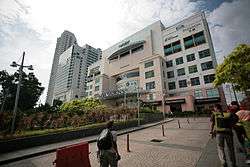
Retail
Due to the numerous shopping malls and hypermarkets in George Town, the city is the main shopping hub of northern Malaysia. This is supported by the large number of tourist arrivals, and Penang's well-developed logistical connections and infrastructure, which facilitated the import of goods. Since 2001, shopping complexes in George Town registered the biggest increases in Malaysia.[160]

In particular, the shopping malls around Komtar and Gurney Drive are the major draws for shoppers. Within the vicinity of Komtar are 1st. Avenue Mall, Prangin Mall and Penang Times Square. Meanwhile, Gurney Plaza and Gurney Paragon are located next to each other along Gurney Drive.
Suburban shopping malls have also been built in recent decades, including Straits Quay and Island Plaza at Tanjung Tokong, Udini Square at Gelugor and All Season's Place at Air Itam.[161][162][163]
While shopping malls now dominate the retail scene in George Town, many centuries-old shophouses are still operating alongside the city's flea markets and wet markets like Chowrasta Market. These smaller retail establishments cater more to locally-made products, including spices, nutmegs and tau sar pneah, a famous Penang delicacy.[164]
This combination of both old and new creates a unique bustling retail sector in George Town.[165] In addition, as many as 24% of Penang's workforce are employed in the retail sub-sector, the largest of all economic sub-sectors in Penang.[141]
Entrepôt Trade
George Town was originally founded by the British as an entrepôt, and right up to the 1950s, George Town maintained the role of one of the major entrepôts in British Malaya.
This entrepôt trade has now greatly declined, due in part to the loss of George Town's free-port status and to the active development of Port Klang near Kuala Lumpur.[35][66][67] However, the Port of Penang still serves as the major harbour within the northern region of Malaysia. As of 2010, the Port of Penang handled over 1.1 million TEU of cargo, the second highest amount in Malaysia.[139]
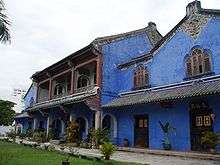

Architecture
Centuries of development have brought a mix of architectural styles to George Town, both historical and modern. The city centre of George Town has been inscribed as a UNESCO World Heritage Site due to its 'unique architectural and cultural townscape without parallel anywhere in East and Southeast Asia'.[82][93] Just outside the UNESCO zone lies the modern cityscape, with skyscrapers, residential high-rises, office blocks and shopping malls built all over the city.
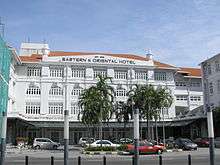
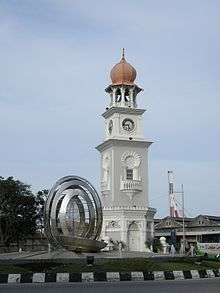
In particular, the older architecture reflects the legacy of 171 years of British presence on Penang Island, coalescing Malay, Chinese, Indian, Peranakan, Siamese, Burmese and other cultural influences. This blend of architectural styles is also visible in Malacca and Singapore, two fellow Straits Settlements which shared similar British colonial legacies. However, unlike Singapore, where many heritage buildings had to make way for modern skyscrapers and high-rise apartments, George Town's architectural heritage has enjoyed a better fate. Conservation efforts since the 2000s have brought previously derelict heritage buildings such as the famous Cheong Fatt Tze Mansion back to life.[166]
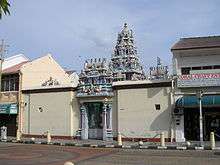
Historical Architecture
Most of George Town's famous heritage landmarks are located within the UNESCO World Heritage Site. One of the first structures to be built in George Town was Fort Cornwallis, which began to be constructed just weeks after Captain Francis Light had first landed in 1786.[42]
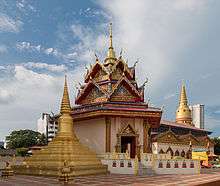
The administrative buildings along Light Street and Farquhar Street, which form the heart of the city, were built in various colonial architectural styles. For instance, the City Hall was built in the Edwardian Baroque style, whereas the Supreme Court features a Palladian architectural style, similar to that of St. George's Church.[167] The Eastern & Oriental Hotel is a sister of Singapore's Raffles Hotel; both were founded by the Sarkies Brothers and feature colonial architecture.
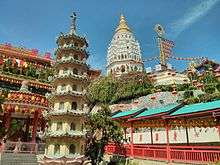
Many of the bank headquarters along Beach Street, such as Standard Chartered Bank and HSBC were also erected in the Art Deco styles.[168][169]
In addition, the UNESCO World Heritage Site is full of various Asian architectural styles, some of them combining different cultural influences. Kapitan Keling Mosque, the biggest mosque within the zone, combines Moorish, Mughal and Islamic styles. Cheong Fatt Tze Mansion and the Pinang Peranakan Mansion both mix Chinese architectural styles and European interior design, while the Sun Yat-sen Museum is one of the countless examples of a typical Peranakan (Straits Chinese) townhouse, which dominates the cityscape.[170][171] Other unique examples of Chinese architecture include the Clan Jetties and Khoo Kongsi. Little India contains more Hindu and Indian Muslim architecture, as can be seen at the Sri Mahamariamman Temple and the Nagore Durgha Shrine.
Impressive heritage architecture can also be found outside the UNESCO World Heritage Site. This includes the colonial bungalows built by nouveau riche Chinese tycoons in the 19th. century along Northam Road (now Jalan Sultan Ahmad Shah), and stately mansions along the roads leading out of the city centre, such as The Residency and Suffolk House.
The Thai and Burmese communities have left their mark on George Town's landscape. At Pulau Tikus, Wat Chayamangkalaram, constructed by the Thais, is well known for its reclining Buddha statue, while Dhammikarama Burmese Temple is located nearby.
Further out into the suburbs, stands Kek Lok Si at Air Itam. The temple, completed in the 1930s, merge Chinese, Siamese and Burmese architectural styles into its main pagoda.
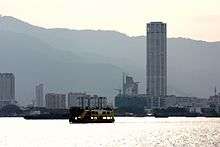
Modern Architecture
Since the mid 20th century, modern urbanisation has transformed much of George Town. Skyscrapers and high-rises have sprung up all over the city, sometimes side-by-side with heritage buildings.
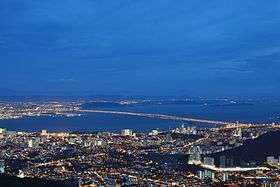
Just south of the UNESCO World Heritage Site stands Komtar, the tallest skyscraper in Penang at nearly 250 meters tall. It forms the core of the modern city centre, surrounded by residential high-rises like Hotel Jen, St. Giles Wembley Hotel, Neo+ Hotel and Penang Times Square, as well as shopping centres including Prangin Mall, 1st. Avenue and Gama.
Skyscrapers and high-rises have also been built along George Town's northern shoreline from Northam Road (now Jalan Sultan Ahmad Shah) to Gurney Drive. Notably, Gurney Paragon, opened in 2013, includes the twin East and West Towers, the second tallest skyscrapers in Penang at 155 meters.
With increasing urbanisation, high-rises are also springing up within the suburban areas of George Town.
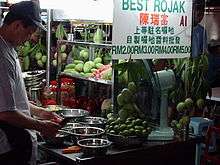
Culture
Food
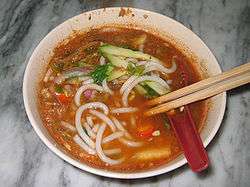
George Town, long known as the food capital of Malaysia, is renowned for its good and varied street food, incorporating Malay, Chinese, Indian, Peranakan, Thai and European influences into its literal melting pot.
The city has been recognised as one of Asia's top street food cities by the CNN, as well the top culinary destination in the world by Robin Barton of the Lonely Planet in 2014.[157][173] These were in addition to the Time magazine in 2004, which acclaimed Penang as having the best street food in Asia, citing that "nowhere else can such great tasting food be so cheap".[174]
The best places to savour Penang cuisine include Gurney Drive, Pulau Tikus, Chulia Street, Kimberley Street, New Lane, New World Park, Penang Road and Air Itam. The more prominent Penang dishes include asam laksa, char kway teow, curry mee, Hokkien mee, nasi kandar, oh chien (fried oyster omelette), rojak and chendol. Besides that, several tau sar pneah shops can be found throughout the city, selling delectable bean paste biscuits.
Performance Arts
George Town hosts a unique form of Chingay procession, which began with its first parade in 1919.[235] Although Chingay parades are held throughout Malaysia and Singapore, Penang's Chingay is unique in that the balancing of enormous flags on one's forehead or hands is an essential component. It is held in celebration of the birthdays of the Chinese deities or in the procession of the Goddess of Mercy (Guan Yin). It was said that Singapore even copied Penang's Chingay processions in order to spice up its own Chinese New Year festivities.[175]
Bangsawan is a Malay theatre art form (often referred to as the Malay opera) which originated from India, developed in Penang with Indian, Western, Islamic, Chinese and Indonesian influences. It went into decline in the latter decades of the 20th century and is a dying art form today.[176][177] Boria is another traditional dance drama indigenous to Penang featuring singing accompanied by violin, maracas and tabla.[178]
Chinese opera (usually the Teochew and Hokkien versions) is frequently performed in George Town, often in specially built platforms, especially during the annual Hungry Ghost Festival. There are also puppetry performances, although they are less performed today.
There are also two major Western orchestras in George Town – the Penang Philharmonic (formerly Penang State Symphony Orchestra and Chorus (PESSOC), and the Penang Symphony Orchestra (PSO), as well as several chamber and school-based musical ensembles.[179][180] Dewan Sri Pinang and the Performing Arts Centre of Penang (Penangpac) at Straits Quay are two of the major performing venues in George Town.
Street Art
In 2012, as part of the George Town Festival, Lithuanian artist Ernest Zacharevic created a series of 6 wall paintings depicting local culture, inhabitants and lifestyles.[181] They now stand as celebrated cultural landmarks of George Town, with Children on a Bicycle being one of the most photographed spots in the area.
Since then, the street art scene has blossomed. Cultural centres such as the Hin Bus Depot are now curating exciting exhibitions and inviting international artists to visit and paint murals, building on the existing reputation the city has as a vibrant arts and culture centre. The art scene is growing beyond this, too, in the funny and entertaining Marking George Town exhibition of wrought iron caricatures waiting to be discovered among the streets.
Museums
The Penang Museum and Art Gallery at Farquhar Street houses relics, photographs, maps, and other artefacts that document the history and culture of Penang and its people.[182] Other museums within the city focuses on religious and cultural aspects, as well as famous personalities, including the Penang Islamic Museum, Sun Yat-sen Museum, Batik Painting Museum and Universiti Sains Malaysia Museum and Gallery.[183]
Other than that, the birthplace of Malaysia's legendary singer-actor, P. Ramlee, has been restored and turned into a museum.[184]
In recent years, private-run museums have sprung up all over George Town, such as the Camera Museum at Muntri Street and Penang Toy Museum at Tanjung Bungah. A handful of newer 3D visual museums have also opened, such as the Made-in-Penang Interactive Museum and the Penang Time Tunnel.[185][186]
Festivals
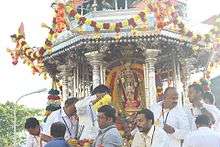
George Town's cultural melting pot of various races and religions means that there are a great many celebrations and festivities in any given year.
Ethnic Chinese celebrate Chinese New Year and the Mid-Autumn Festival. In addition to these, the Taoists observe the Hungry Ghost Festival, Qing Ming, and the feast days of various deities.
Meanwhile, the Muslims observe Hari Raya Aidilfitri, Hari Raya Haji, and Maulidur Rasul with open houses throughout the city. The Hindus celebrate Deepavali, Thaipusam and Thai Pongal, while the Sikhs commemorate Vaisakhi. Christian celebrations of Christmas, Good Friday and Easter are also widely celebrated. Vesak Day is observed by both major schools of Buddhism.
Bon Odori is an annual event held at the Esplanade by the expatriate Japanese population, while the Thais in George Town celebrate Songkran.
In recent years, the Penang state government has been organising the annual George Town Festival each August.[187] The George Town Festival has grown into one of the most highly anticipated cultural events in Malaysia, with an estimated annual participation of over 200,000 people from all over the world.[188][189]
Another well-known festival is the Penang Hot Air Balloon Fiesta, typically held every February at the Polo Ground.[190][191] This particular festival has attracted Malaysian and international balloonists, such as from Belgium, the Netherlands and the United States.
Sports


George Town has produced some of Malaysia's sporting greats. Nicol David, considered by some to be the world's greatest female squash player of all time, was born in George Town and had trained at Gelugor at a young age.[192][193] Fellow squash players Low Wee Wern and Ong Beng Hee also hailed from George Town, as is Chan Peng Soon, who won a silver medal at the 2016 Olympics in mixed doubles badminton.
The city also houses relatively well-developed sporting infrastructure. The City Stadium at Dato' Keramat Road is Penang's main football stadium, with a capacity of around 40,000.[194] The stadium is the home ground of Penang FA. The SPICE Arena at Relau has an indoor stadium and an aquatics centre, while the Nicol David International Squash Centre at Gelugor is a major squash training facility.[195] In addition, the Penang Turf Club, established in 1864, is Malaysia's oldest horse racing and equestrian centre.[232]
The Penang Bridge Marathon is a popular annual event. The full marathon route starts from near Queensbay Mall, to the Bayan Lepas Expressway, then on to the 13.5 km (8.4 mi) length of the Penang Bridge, and finally back to the starting point for the finish. This event hosted 24,000 runners in 2010.[234]
Sports clubs in George Town include the Penang Club, Chinese Recreation Club (CRC), Penang Sports Club, Penang Rifle Club, Penang Polo Club, Penang Swimming Club, Chinese Swimming Club, and the Penang Squash Centre.
George Town has also hosted national and international sport events include the 2000 Sukma Games and the 2013 Women's World Open Squash Championship.
Education
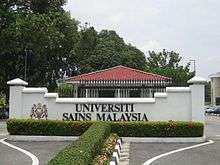
George Town is home to some of the oldest schools in Malaysia, making it a pioneer in Malaysia's education system. Under British rule, missionary schools, beginning with Penang Free School in 1816, were set up across George Town. These English-medium schools educated some of Malaysia's most influential figures, including lawmakers, politicians, professionals and businessmen. They were followed by Chinese schools, some of which are also among the oldest in the country, thus making George Town the nucleus of Chinese education in South-east Asia.
More recently, international schools have been established to cater to the growing expatriate population. These international schools offer primary to secondary education up to A Levels and International Baccalaureate.
George Town is also home to one of the best Malaysian public universities - Universiti Sains Malaysia, as well as several private colleges and institutions.
These educational institutions have contributed to George Town's relatively educated populace and led to Penang having the third highest Human Development Index in Malaysia. Overall, Penang had a recorded literacy rate of 98.2% in 2010.[196]
Secondary Education
Missionary Schools
During the colonial era, George Town boasted a good education system which stretched back to the early years of British rule. Some of these schools are among the oldest in South-east Asia, and have educated generations of rulers, lawmakers, politicians, professionals and people of social standing.
- Penang Free School, founded in 1816, is the oldest English school in South-east Asia. Notable alumni include Tunku Abdul Rahman, P. Ramlee, Wu Lien-teh and Lim Chong Eu.
- St. Xavier's Institution, established in 1852, is the oldest Catholic La Sallian school in Malaysia. Notable alumni include Karpal Singh, Wong Pow Nee and Hon Sui Sen.
- Convent Light Street, also founded in 1852, is the oldest girls' school in Malaysia.
- Convent Green Lane
- Convent Pulau Tikus
- St. George's Girls' School
- Methodist Boys' School
- Methodist Girls' School
Today, these missionary schools have been converted into national schools, although they still maintain their English traditions.
Chinese Schools
George Town became the nucleus of Chinese education in South-east Asia, when the first Chinese school was established in the 1900s. Since then, the city has been the centre of Malaysia's Chinese-language schooling system. These schools were set up by local Chinese associations with donations from philanthropists, and have historically attracted students from Chinese communities in Thailand and Indonesia, where Chinese education was banned. These schools are well-supported by the community and many consistently produce good results, thus attracting non-Chinese students too.
- Chung Hwa Confucian School, established in 1904, is one of the oldest formal Chinese schools in South-east Asia. It also became the first to use Mandarin as the medium of instruction instead of other Chinese dialects.
- Chung Ling High School, founded in 1917, was the alma mater of Khaw Boon Wan, Lee Khoon Choy and Koh Tsu Koon.
- Han Chiang High School
- Penang Chinese Girls' High School
- Union High School
- Convent Datuk Keramat
- Phor Tay High School, established in 1940, was the first Buddhist school in Malaysia.
- Heng Ee High School
National, Vocational, and Islamic Schools
National schools use Malay as their medium of instruction. Unlike early Chinese and missionary schools, national schools are mostly built and funded by the Malaysian federal government. Examples include Hamid Khan High School, Sri Mutiara High School and Air Itam High School.
The Tunku Abdul Rahman Technical Institute and the Batu Lanchang Vocational School are two of George Town's government-run vocational schools.
The Al-Mashoor High School is an Islamic religious school in the city.
International Schools
- Dalat International School
- Uplands International School
- Tenby International School
- Pelita International School
- Penang Japanese School
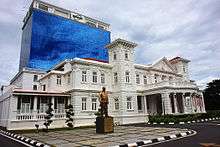
Tertiary Education
Universiti Sains Malaysia, situated at Gelugor, is one of the best Malaysian public universities. Established in 1969 as Malaysia's second university, it was originally named Universiti Pulau Pinang (University of Penang).[197] As of 2016, it is ranked 330th in the QS World University Rankings, the fifth highest in Malaysia.
Several private institutions have also been set up across George Town.
|
|
|
Libraries
The Penang State Library has a branch at Scotland Road.[198][199] Other private libraries can be found in schools, colleges, or universities.
Health Care
The numerous public and private hospitals in George Town has helped the city to emerge as the centre of medical tourism in Malaysia. The public health care system first established by the British authorities was supplemented by health care provided by local Chinese charities, and Christian missionaries such as the Roman Catholic and the Seventh-day Adventist.
The Penang General Hospital, administered and funded by the Ministry of Health, is the main public hospital for George Town. Built in 1882, it now also serves as the reference hospital within the northern region of Malaysia.[200] A medical school within the hospital is slated for completion by 2017.
Private hospitals supplement the system with better facilities and speedier care. These hospitals cater not only to the local population but also to patients from other states and health tourists from neighbouring countries such as Indonesia and Singapore.[201] Penang is actively promoting health tourism, given its considerable contribution to the state's economy. The city has attracted approximately half of Malaysia's medical tourist arrivals in 2013 and generated about 70% of the nation's medical tourism revenue.[16][17][72]
Hospices are also increasingly becoming the choice for long-term and terminal care. Infant mortality rate at present is 0.4% while life expectancy at birth is 71.8 years for men and 76.3 years for women.
Public hospital
|
Private hospitals
|
Media
George Town was once the centre of Malaysian print media. The country's first newspaper was established in the city – the Prince of Wales Island Gazette in 1805. This was followed by the Penang Gazette, first published in 1837.[202] One of Malaysia's top newspapers in circulation today, The Star, has its origins as a regional daily founded in George Town in the 1970s, while the oldest Chinese newspaper in the country, Kwong Wah Yit Poh, was also founded in the city in 1910.
The mainstream newspapers in George Town include the English dailies The Star, The New Straits Times, and the free The Sun; the Malay dailies Berita Harian, Utusan Malaysia, Harian Metro, and Kosmo!; the Chinese dailies Kwong Wah Yit Poh, Sin Chew Daily, China Press, and Oriental Daily News; and the Tamil dailies Tamil Nesan, Malaysia Nanban, and Makkal Osai. The Malay Mail is an English weekly. Nanyang Siang Pau is a Chinese-language financial daily while The Edge is an English-language financial weekly newspaper. All of them are in national circulation.
In 2011, Chief Minister of Penang Lim Guan Eng officiated the launch of Time Out Penang.[203] The Penang edition of the international listings magazine is currently published in three versions: a yearly printed guide, a regularly updated website, and mobile app.[204] The Penang state government also publishes its own multi-lingual newspaper, Buletin Mutiara, which is circulated for free every fortnight. The Penang-centric newspaper focuses on the current issues affecting Penang.
The television stations available in George Town are national media RTM's TV1 and TV2, and privately-owned TV3, NTV7, 8TV and TV9. Programmes are broadcast in Malay, English, Chinese and Tamil. A pay television service, Astro, is also widely in subscription in the city, as it broadcasts international television channels such as CNN International Asia Pacific, BBC World News, Channel News Asia, STAR World, FOX Movies Premium and HBO Asia.
Due to its well-preserved heritage cityscape, George Town has been used as a backdrop in a number of movies, such as Anna and the King and Lust, Caution. Singaporean drama series, The Little Nyonya and The Journey: Tumultuous Times, were also shot within the UNESCO World Heritage Site. In addition, George Town was one of the pit-stops of The Amazing Race 16 and The Amazing Race Asia 4.
The available FM radio stations in George Town, both government (including Penang-based Mutiara FM) and commercial, are as listed below.
| Frequency | Station | Operator | Language |
|---|---|---|---|
| 87.8 | One FM | Media Prima | Mandarin, Cantonese |
| 88.2 | Hot FM | Media Prima | Malay |
| 89.9 | Fly FM | Media Prima | English |
| 91.0 | Mix FM | AMP Radio Networks | English |
| 92.8 | Hitz FM | AMP Radio Networks | English |
| 93.9 | Mutiara FM | RTM | Malay |
| 94.5 | 988 FM | Star RFM Radio | Mandarin, Cantonese |
| 94.9 | Klasik FM | RTM | Malay |
| 96.7 | Minnal FM | RTM | Tamil |
| 97.1 | Sinar FM | AMP Radio Networks | Malay |
| 98.1 | Red FM | Star RFM Radio | English |
| 98.7 | TraXX FM | RTM | English |
| 99.3 | THR FM | AMP Radio Networks | Tamil |
| 99.7 | My FM | AMP Radio Networks | Mandarin, Cantonese |
| 101.3 | Ai FM | RTM | Mandarin, Cantonese, Hokkien |
| 102.4 | Suria FM | Star RFM Radio | Malay |
| 103.6 | Era FM | AMP Radio Networks | Malay |
| 104.4 | Lite FM | AMP Radio Networks | English |
| 107.6 | Capital FM | Star RFM Radio | English |
Transportation
As one of Malaysia's major cities, George Town's logistical infrastructure is well-developed, enabling extensive connections via land, air and sea. Within the city, George Town's compact size and a well-developed road network allow for ease of travel for locals and tourists alike.
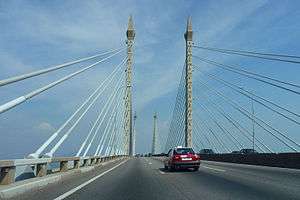
Land
Development of George Town's streets and roads is an ongoing process that dates back to the early years of British rule. Today, the city has inherited an extensive road network. Outside the narrow streets of the city centre, more modern roads link the city centre with the surrounding suburbs of Tanjung Tokong, Air Itam, Jelutong and Gelugor.
The Jelutong Expressway, now renamed as Tun Dr Lim Chong Eu Expressway, runs along the eastern coastline of Penang Island between the city centre and the Penang International Airport, linking both locations with the Bayan Lepas Free Industrial Zone and the Penang Bridge.
The 13.5 km-long Penang Bridge, together with the more southerly Second Penang Bridge, links Penang Island with the rest of Peninsular Malaysia.
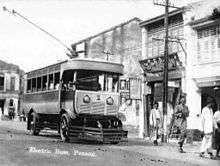
Public Transportation
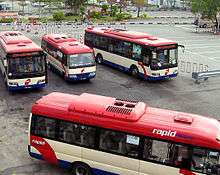
The earliest mode of transportation in George Town was the horse hackney carriage, which was popular throughout the last quarter of the 18th century until 1935, when the rickshaw gained popularity, until it in turn was rapidly superseded by the trishaw beginning in 1941. To this day, trishaws still ply the streets of George Town, primarily catering for tourists.[205]
Horse trams, steam trams, electric trams, trolleybuses and double deckers used to ply the streets of George Town. The first steam tramway started operations in the 1880s, and for a time, horse-drawn cars were also introduced. Electrical trams were launched in 1905. Trolleybuses commenced in 1925 and they gradually supplanted the trams but they in turn were discontinued in 1961 and regular buses henceforth became the only form of public transport to this day.[206][207]
For a long time, public bus services, plagued by intense rivalry between the different bus companies, were deemed unsatisfactory.[208][209][210] In 2007, the Malaysian federal government announced that Prasarana Malaysia, which runs Rapid KL, would take over all public bus services in Penang under a new entity named Rapid Penang.
Rapid Penang started out with 150 buses covering 28 routes on Penang Island. This service has since been extended and in the process, public transportation has improved. Public bus usage within Penang has also increased from a lowly 30,000 commuters a day in 2007 to 75,000 commuters a day in 2010.[211] Currently, there are 350 buses plying 41 routes around the state, with 30 of the routes on Penang Island. Besides that, the Penang Island City Council, with the collaboration of Rapid Penang, has introduced free shuttle bus services for short commutes within the centre of George Town to lessen traffic congestion.[208] Recently, open-air double decker buses, known as Hop-On Hop-Off buses, have also been introduced for tourists in the city.[212]
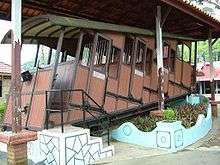
Express buses linking George Town with the rest of Peninsular Malaysia, Singapore and southern Thailand utilise the Sungai Nibong Bus Terminal, south of the city, as their Penang Island terminus.
The only rail-based transportation system in George Town is the Penang Hill Railway, a funicular railway to the peak of Penang Hill. When completed in 1923, the railway, then utilising Swiss-made coaches, was considered an engineering feat of sorts. It underwent an extensive upgrading in 2010 and was reopened in early 2011.[213]
Within the city centre, efforts are being undertaken to promote pedestrianisation and the use of bicycles as a greener alternative transportation mode.[214] Rental bicycles are being introduced and marketed by several companies within the UNESCO World Heritage Site, while dedicated cycling lanes have been marked throughout the city.[215][216]
Since 2015, Uber, a private car hailing service, has been made available throughout Penang.[217]
There are plans by the Penang state government to introduce more rail-based transportation systems throughout Penang. The Penang Transport Master Plan envisages the following long-term solutions to counter George Town's increasing traffic congestion.
- Light Rail Transit line between Komtar and the Penang International Airport[218]
- Monorail lines linking Komtar with the suburbs of Air Itam, Paya Terubong and Tanjung Tokong[219][220]
- Return of the trams, limited to within George Town's UNESCO World Heritage Site[221]
- Overhead cross-strait cable car linking Komtar and Penang Sentral in Butterworth[222]
With the completion of the plan slated in 2030, the Penang state government aims to have multiple public transportation systems on the ground, at sea and even in the air.
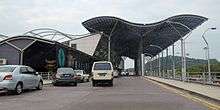
Air
The Penang International Airport, 14 km south of George Town, was opened in 1935 while Penang was part of the Straits Settlements, making it the oldest airport in Malaysia. It serves as the main airport for the northern region of Malaysia, with extensive links to major regional cities.
The airport connects Penang with several major Asian cities, including Kuala Lumpur, Singapore, Bangkok, Jakarta, Hong Kong, Guangzhou, Taipei, Ho Chi Minh City and Yangon.[223][224] It is also the hub for two Malaysian low-cost carriers - AirAsia and Firefly.
The airport is one of the nation's busiest, with the second largest cargo traffic and the third highest passenger traffic as of 2013. This reflects Penang Island's role as a major tourism attraction and a manufacturing hub. Due to its proximity to the Bayan Lepas Free Industrial Zone, the airport plays a vital part in facilitating the transport of goods and products to and from the factories in Bayan Lepas.
Sea
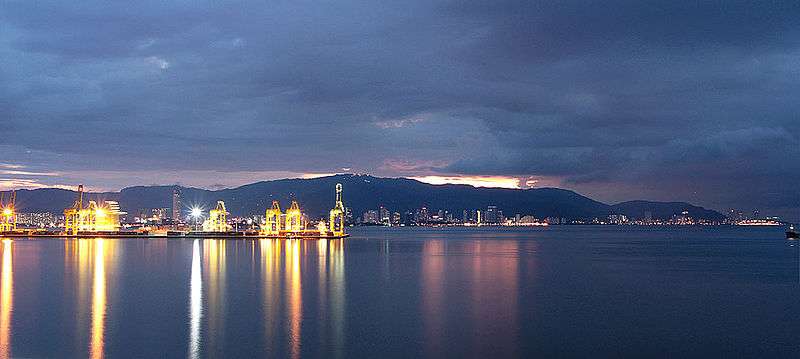
The Port of Penang is one of the major ports of Malaysia and the most important harbour within the northern region of the country. The Port consists of four terminals - one in George Town and three in the town of Butterworth across the Penang Strait.
Over the past decades, the loss of George Town's free port status and the development of Port Klang, near Kuala Lumpur, have somewhat reduced the Port of Penang's trade volume.[35][67] Nonetheless, the Port still plays an important role for northern Malaysia, as it links George Town with more than 200 ports worldwide.[19] As of 2010, the Port of Penang handled over 1.1 million TEU of cargo, the second highest amount in Malaysia.[139]
In addition, Swettenham Pier also accommodates cruise ships, making it one of the major entry points into George Town (and the most direct one, as it is located within the UNESCO World Heritage Site).[225] This also makes cruise tourism a major component of tourism arrivals into Penang. As of 2014, Swettenham Pier recorded 1.2 million tourist arrivals and attracted some of the world's largest cruise liners, such as the RMS Queen Mary 2.[153] A number of cruise ships also call Swettenham Pier as their homeport, bringing tourists into and out of George Town towards regional destinations like Phuket and Singapore.
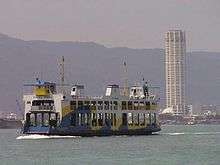
Occasionally, Swettenham Pier hosts warships as well, including those from Singapore, Thailand and the United States.[226][227][228]
Penang Ferries
The Penang Ferry Service connects George Town with the town of Butterworth on the Malay Peninsula, serving as a convenient mode of transportation across the Penang Strait for the residents of George Town. It is the oldest ferry service in Malaysia, having been in operation since 1920. Currently, four ferries ply the Penang Strait between George Town and Butterworth daily.[229] There have been concerns in recent years over the loss-making Penang Port Commission, a Malaysian federal government agency that runs the ferry service.[230]
Utilities
Water supply in George Town, which comes under the purview of the Penang state government, is wholly managed by the state-owned but autonomous PBA Holdings Bhd, whose sole subsidiary is the Perbadanan Bekalan Air Pulau Pinang Sdn Bhd (PBAPP). This public limited company provides reliable, round-the-clock drinking water throughout the state. Penang was cited by the World Development Movement as a case study in successful public water scheme.[231] PBA's water rates are also one of the lowest in the world[232]
George Town was among the first towns in Malaya to be electrified in 1905 upon the completion of the first hydroelectric scheme.[233] At present, electricity for industrial and domestic consumption is provided by the national electricity utility company, Tenaga Nasional Berhad (TNB).
Telekom Malaysia Berhad is the landline telephone service provider and an Internet service provider (ISP) in Penang. Mobile network operators and mobile ISPs include Maxis, Digi, Celcom, and U Mobile.
As of the first quarter of 2014, Penang had a recorded broadband penetration rate of 80.3%, the highest among all Malaysian states (excluding Kuala Lumpur).[234] Currently, the Penang state government is in the process of implementing a statewide Wi-Fi service. Known as Penang Free Wi-Fi, it aims to improve internet penetration throughout Penang and is provided free-of-charge.[235] As of 2015, its bandwidth speeds are being increased to 3Mbit/s within the centre of George Town, while 1,560 hotspots have been installed throughout Penang.[236] When completed, Penang will be the first state in Malaysia to provide its citizens with free Internet connection.[237]
Sewage treatment in George Town is managed by the national sewerage company, Indah Water Konsortium. Prior to systematic sewerage piping and treatment, waste water was haphazardly disposed, mostly in the sea, causing coastal water degradation.[238]
International Relations
Consulates
Befitting George Town's status as a major Malaysian city with various multi-national economic and social interests, several nations have either established their consulates or appointed honorary-consulates within George Town.
Sister Cities
George Town has six sister cities.
City Firsts
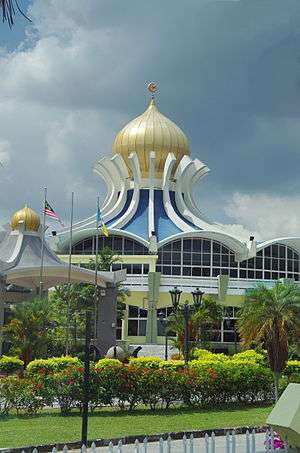

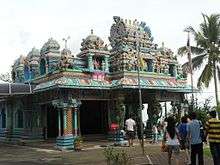
- George Town became the first British settlement in South-east Asia in 1786.
- The first newspaper in Malaysia made its appearance in George Town in 1805 – the Prince of Wales Island Gazette.[202]
- The Royal Malaysian Police was established when King George III awarded Penang a 'Charter of Justice' in 1807 to form the police force and the Court of Justice.
- The Supreme Court of Penang, established in 1808, was the first to be established in British Malaya and formed the foundations of Malaysia's legal system.
- College General is the only Catholic seminary in Peninsular Malaysia founded in 1665 in Ayutthya, Thailand and then relocated to Penang in 1808.
- St. George's Church, established in 1816, is the oldest Anglican Church in South-east Asia.
- Penang Free School, founded by Rev. Sparke Hutchings in 1816, is the first and oldest English School in South-east Asia.
- Sekolah Kebangsaan Gelugor, founded in 1826, is the first Malay school to be established in Malaysia.[263]
- St Xavier's Institution established in 1852, is the first school established in Malaysia to be administered and fully owned by the La Salle Brothers.[264]
- Convent Light Street, a girls' school established by a French Sisters' Mission in 1852, is the oldest girls' school in South-east Asia.
- The Penang Island City Council is the successor of the Municipal Council of George Town, which was established in 1857 as the first local council in British Malaya.
- The Penang Turf Club, established in 1864, is Malaysia's oldest horse racing and equestrian centre.
- Standard Chartered Bank, the oldest bank in Malaysia, opened its doors in 1875.
- Penang Botanic Gardens, established in 1884, is the first botanic gardens in Malaysia.
- George Town Dispensary is the earliest dispensary in British Malaya. It was opened in 1895.
- Chung Hwa Confucian School, founded in 1904, is one of the oldest formal Chinese schools established in South-east Asia.
- In 1905, Penang completed its first hydroelectric scheme.[265]
- In 1906, George Town's first electric tramway made its appearance.[265]
- Malaysia's oldest Chinese newspaper still in circulation today, Kwong Wah Yit Poh, was founded in 1910 by Dr. Sun Yat-sen in George Town.
- The Penang Ferry Service, which began operations in 1920, is the oldest ferry service in Malaysia.
- The Penang Hill Railway, opened in 1923, is the first funicular hill railway in Malaysia.
- St. Nicholas' Home, a social outreach ministry under the Anglican Church founded in 1926, is first charitable organisation serving the needs of the blind and visually impaired community of Malaysia. St. Nicholas' Home also started the first blind school in Malaysia.
- Phor Tay High School, founded in 1940, is the first Buddhist school in Malaysia.
- Federation School for the Deaf, is the first deaf school in the Federation of Malaya in April 1954.
- Diocese of Penang in 1955 is the first Catholic diocese in Malaysia to have a local bishop at helm.
- George Town, the capital of Penang, was declared a city by Queen Elizabeth II on 1 January 1957, becoming the first city in the Federation of Malaya and subsequently, Malaysia.
- Penang Island is the only island in Malaysia to be connected to the Malay Peninsula through land transport when the Penang Bridge was completed in 1985.
- Penang is the first state in Malaysia to implement the 'No Plastic Bag' ruling in 2011, virtually banning the use of plastic bags every day by almost all business sectors.[266]
- The Camera Museum, newly established in 2012, is South-east Asia's first and only Camera Museum with extensive collections & the origin of the invention.
- George Town and Malacca are the first cities in Malaysia to be granted the UNESCO World Heritage Site status on 8 July 2008.[267]
- Penang's water tariffs are amongst the lowest in Malaysia.
See also
Notes
- ↑ The new cenotaph was built on 11 November 1948 as a replacement for an earlier cenotaph that had been destroyed by both the Japanese and Allied bombings in World War II.
References
- ↑ Mike Aquino (30 August 2012). "Exploring Georgetown, Penang". Asian Correspondent. Retrieved 1 January 2016.
- ↑ Goh Ban Lee (19 May 2014). "The Penang Island City agenda". The Sun. Retrieved 25 January 2016.
- ↑ Cavina Lim (25 March 2015). "Penang's first mayor a woman". The Star. Retrieved 24 January 2016.
- ↑ "Malaysia Elevation Map (Elevation of George Town)". Flood Map : Water Level Elevation Map. Archived from the original on 16 March 2015. Retrieved 25 September 2015.
- ↑ "The Penang Island City agenda". The Sun Daily. 19 May 2014.
- ↑ http://www.zairil.com/tag/stepchild/
- 1 2 3 4 Usman Haji Yaakob; Nik Norliati Fitri Md Nor (2013). "The Process and Effects of Demographic Transition in Penang, Malaysia" (PDF). School of Humanities. University of Science, Malaysia. pp. 42, 45 6, 9/28. Retrieved 25 January 2016.
- ↑ Homi Kharas; Albert Zeufack; Hamdan Majeed (September 2010). "Cities, People & the Economy – A Study on Positioning Penang" (PDF). Khazanah Nasional, World Bank. ThinkCity. pp. 5, 12/105. ISBN 978-983-44193-3-2. Retrieved 26 January 2016.
- ↑ Hamdan Abdul Majeed (11 April 2012). "Urban Regeneration : The Case of Penang, Malaysia (Putting Policy into Practice) – The Penang Metropolitan Region (George Town Conurbation)" (PDF). Khazanah Nasional. World Bank. pp. 10/20. Archived from the original (PDF) on 4 January 2016. Retrieved 4 January 2016.
- 1 2 "Eight new sites, from the Straits of Malacca, to Papua New Guinea and San Marino, added to UNESCO's World Heritage List". UNESCO (World Heritage Site). 7 July 2008. Archived from the original on 6 September 2015. Retrieved 8 July 2008.
- ↑ http://travel.cnn.com/explorations/eat/asia-street-food-cities-612721/
- ↑ http://travel.cnn.com/george-town-penang-asias-greatest-street-food-city-657636/
- ↑ http://www.independent.co.uk/travel/news-and-advice/where-are-the-foodies-going-in-2014-9094744.html
- ↑ http://www.latimes.com/travel/la-tr-d-16-places-20151227-story.html
- ↑ Christina Oon Khar Ee; Khoo Suet Leng (2004). "Issues and challenges of a liveable and creative city: The case of Penang, Malaysia" (PDF). Development Planning and Management Programme, School of Social Sciences, University of Science, Malaysia. p. 1/11. ISSN 2180-2491. Archived from the original (PDF) on 26 January 2016. Retrieved 26 January 2016.
- 1 2 3 4 http://penangmonthly.com/medical-tourism-a-billion-ringgit-industry-for-penang/
- 1 2 3 http://www.thesundaily.my/news/1260128
- ↑ http://www.worldportsource.com/ports/commerce/MYS_Port_of_Penang_1425.php
- 1 2 http://penangport.com.my/Profile/About-Penang-Port
- ↑ Abu Talib Ahmad (10 October 2014). Museums, History and Culture in Malaysia. NUS Press. pp. 233–. ISBN 978-9971-69-819-5.
- ↑ Editor Muhammad Haji Salleh (27 August 2015). Early History of Penang (Penerbit USM). Penerbit USM. pp. 39–40. ISBN 978-983-861-657-7.
- ↑ "The Penang connection". The Hindu. 18 August 2014. Archived from the original on 8 January 2016. Retrieved 8 January 2016.
- ↑ Usman Haji Yaakob; Nik Norliati Fitri Md Nor (2013). "The Process and Effects of Demographic Transition in Penang, Malaysia" (PDF). School of Humanities. University of Science, Malaysia. pp. 42, 45 6, 9/28. Retrieved 25 January 2016.
- 1 2 3 III, Administrator. "History of Penang". www.visitpenang.gov.my. Retrieved 15 October 2016.
- ↑ "JourneyMalaysia » The Arrival of the British and East India Company ~ Pulau Pinang / Penang , Malaysia (Article)". www.journeymalaysia.com. Retrieved 15 October 2016.
- ↑ Swettenham; Frank Athelstane (1850–1946). "Map to illustrate the Siamese question". W. & A.K. Johnston Limited. University of Michigan Library. Retrieved 9 January 2016.
- ↑ Simon Richmond (2010). Malaysia, Singapore & Brunei. Lonely Planet. pp. 177–. ISBN 978-1-74104-887-2.
- ↑ Ashley Jackson (November 2013). Buildings of Empire. OUP Oxford. pp. 7–. ISBN 978-0-19-958938-8.
- ↑ "Malaysian Journal of Society and Space". Charting the early history of Penang trading networks and its connections with the new ASEAN growth triangle (Malaysia-Indonesia-Thailand).
- ↑ Nordin, Hussin (1 December 2005). "Networks of Malay Merchants and the Rise of Penang as a Regional Trading Centre". The southeast asian studies. 43 (3): 215–237. ISSN 0563-8682.
- ↑ "pg.3 - Chapter 1 - Early Penang Society (contd)". 100pfs.blogspot.my. Retrieved 15 October 2016.
- ↑ "The Penang Story". A Comparison on the Urban Spatial Structures of the British Colonial Port Cities among Calcutta, George Town and Singapore.
- ↑ "Too close for comfort for Penang folks - Star2.com". Star2.com. 14 April 2016. Retrieved 15 October 2016.
- ↑ "ASEAN Conference on Environment-Behaviour Studies". Urban Landscape Factors That Influenced the Character of George Town, Penang Unesco World Heritage Site.
- 1 2 3 4 5 6 7 http://profile.nus.edu.sg/fass/socgohd/trans_2.1.pdf
- ↑ "Singapore becomes admin centre of the Straits Settlements - Singapore History". eresources.nlb.gov.sg. Retrieved 15 October 2016.
- 1 2 "The Penang Story". Penang's Changing Role in the Straits Settlements, 1826-1946.
- ↑ Khoo, Salma Nasution (2009). Penang and Its Region: The Story of an Asian Entrepôt. Singapore: National University of Singapore. ISBN 9789971694234.
- ↑ "When Penang became a Spice Island". Penang Monthly. 21 January 2016. Retrieved 15 October 2016.
- ↑ Khoo, Su Nin (2007). Streets of George Town, Penang. Penang: Areca Books. ISBN 9789839886009.
- ↑ Wong, Yee Tuan (2015). Penang Chinese Commerce in the 19th Century: The Rise and Fall of the Big Five. Singapore: ISEAS-Yusof Ishak Institute. ISBN 9789814515023.
- 1 2 Langdon, Marcus (2014). George Town's Historic Commercial and Civic Precints. Penang: George Town World Heritage Incorporated.
- ↑ "Asian Studies". Government Legislation for Chinese Secret Societies in the Straits Settlements in the Late 19th. Century.
- ↑ Ajay Kamalakaran (20 May 2015). "Battle of Penang: When Malay fishermen rescued Russian sailors". Russia Beyond the Headlines. Retrieved 12 January 2016.
- ↑ Streets of George Town, Penang. Areca Books. 2007. pp. 5–85. ISBN 978-983-9886-00-9.
- ↑ Jin Seng Cheah (19 February 2013). Penang 500 Early Postcards. Editions Didier Millet. pp. 71–. ISBN 978-967-10617-1-8.
- 1 2 3 Barber, Andrew (2010). Penang At War : A History of Penang During and Between the First and Second World Wars 1914-1945. AB&B.
- ↑ Alan Warren (2006). Britain's Greatest Defeat: Singapore 1942. A&C Black. pp. 109–. ISBN 978-1-85285-597-0.
- ↑ Nick Shepley (7 December 2015). Red Sun at War Part II: Allied Defeat in the Far East. Andrews UK Limited. pp. 21–. ISBN 978-1-78166-301-1.
- ↑ "Penang Evacuated - British Garrison Withdrawn NEW JAP THRUSTS IN MALAYA London, December 19 - Northern Times (Carnarvon, WA : 1905 - 1952) - 20 Dec 1941". Trove. Retrieved 15 October 2016.
- 1 2 Bayly, Christopher (2005). Forgotten Armies: The Fall of British Asia, 1941-1945. Harvard University.
- ↑ Chen, C. Peter. "Invasion of Malaya and Singapore". WW2DB. Retrieved 15 October 2016.
- ↑ Netto, Anil (6 October 2013). "Old Penang: The Sook Ching massacres of World War II - anilnetto.com". anilnetto.com. Retrieved 15 October 2016.
- ↑ "uboat.net - U-boat Operations- The Monsun U-boats - 3. Monsun boats". www.uboat.net. Retrieved 15 October 2016.
- ↑ "German U-Boat Operations in Australian Waters".
- ↑ "Nazi U-boat sunk during Second World War is discovered off Indonesia". Mail Online. Retrieved 15 October 2016.
- ↑ "World War II: Yanagi Missions -- Japan's Underwater Convoys | HistoryNet". www.historynet.com. Retrieved 15 October 2016.
- ↑ Borsa, Arnaldo. "Italian Royal Navy in World War Two: Italian surface units in Far East". www.icsm.it. Retrieved 15 October 2016.
- ↑ Kratoska, Paul. War and Occupation in Penang, 1941–1945. Singapore: National University of Singapore.
- ↑ Paul H. Kratoska (1998). The Japanese Occupation of Malaya: A Social and Economic History. C. Hurst & Co. Publishers. pp. 296–. ISBN 978-1-85065-284-7.
- ↑ "Penang: The Rebel State (Part One)". Penang Monthly. 1 September 2016. Retrieved 15 October 2016.
- 1 2 "Penang: The Rebel State (Part Two)". Penang Monthly. 1 October 2016. Retrieved 15 October 2016.
- 1 2 Christie, Clive (1998). A Modern History of Southeast Asia: Decolonization, Nationalism and Separatism. I.B.Tauris. ISBN 9781860643545.
- ↑ "Newspaper Article - "Gallup Poll" On Penang Secession". eresources.nlb.gov.sg. Retrieved 15 October 2016.
- ↑ "Journal of Southeast Asian Studies". The Penang Secession Movement, 1948–1951.
- 1 2 Brash, Celeste (2008). Kuala Lumpur, Melaka and Penang. Lonely Planet. ISBN 9781741044850.
- 1 2 3 Eckhardt, Robyn (2 December 2010). "In Malaysia, Tourists Are Lured by George Town's Colorful Past". The New York Times. ISSN 0362-4331. Retrieved 16 October 2016.
- ↑ "Brain-drain debate after Penang loses $4b deal". news.asiaone.com. Retrieved 15 October 2016.
- ↑ "Penang launches RM20m scholarship to reverse brain drain". 1 April 2015. Retrieved 15 October 2016.
- ↑ Jakobsen, Michael (2014). Ethnic Chinese Entrepreneurship in Malaysia: On Contextualisation in International Business Studies. Routledge. ISBN 9781317594031.
- ↑ Kaur, Arunajeet (2010). The Migration of Indian Human Capital: The Ebb and Flow of Indian Professionals in Southeast Asia. Routledge. ISBN 9781134018161.
- 1 2 3 4 5 "Higher Education in Regional and City Development : State of Penang, Malaysia". OECD.
- ↑ "Penang Island Municipal Council seeks city status status | theSundaily". www.thesundaily.my. Retrieved 15 October 2016.
- ↑ "After four-year wait, Penang Island to finally get city status". 17 December 2014. Retrieved 15 October 2016.
- ↑ "Where is George Town?". 4 April 2015. Retrieved 15 October 2016.
- ↑ "myPenang - Penang's a City". www.mypenang.gov.my. Retrieved 15 October 2016.
- ↑ "Komtar, George Town, Penang / Pulau Pinang". Retrieved 15 October 2016.
- ↑ "Komtar: Malaysia's Monument to Failed Modernism — Failed Architecture". Retrieved 15 October 2016.
- ↑ "Penang's iconic Komtar gets RM50m facelift". 29 October 2013. Retrieved 15 October 2016.
- ↑ Loh, Arnold. "Much of Komtar's charm is gone - Nation | The Star Online". Retrieved 15 October 2016.
- ↑ "Asia Times: Wreckers ball rips heart out of city: Car Rentals at www.The-Car-Reservations-Desk.com". www.atimes.com. Retrieved 15 October 2016.
- 1 2 3 III, Administrator. "About Penang - City of Life". www.visitpenang.gov.my. Retrieved 13 October 2016.
- ↑ Chow, Tan Sin. "Penang's capital is eighth most liveable city in Asia, on par with KL and Bangkok - Nation | The Star Online". Retrieved 15 October 2016.
- ↑ "Penang most liveable city in M'sia - Community | The Star Online". Retrieved 15 October 2016.
- ↑ "quality of life". Penang Monthly. Retrieved 15 October 2016.
- ↑ "Penang as an 'entrepreneurial state' | Buletin Mutiara". www.buletinmutiara.com. Retrieved 15 October 2016.
- ↑ "Making George Town more walkable, one street at a time". 9 August 2016. Retrieved 15 October 2016.
- ↑ "Penang shining, thanks to Guan Eng". Free Malaysia Today. 18 March 2012. Retrieved 15 October 2016.
- ↑ "Guan Eng lifts from Singapore playbook in ambitious bid to make Penang world class (VIDEO)". 14 May 2016. Retrieved 15 October 2016.
- ↑ Looi Sue-Chern (24 March 2015). "George Town a city again". The Malaysian Insider. Archived from the original on 26 March 2015. Retrieved 24 January 2016.
- ↑ Hairunnisa Md Arus; Dr. Mohd Effendi Daud; Najihah Remali (13–14 December 2012). "Seminar Teknikal Kebangsaan Gempa Bumi dan Tsunami (Study Area) – Implementing Thematic Indices Combination Technique for Tsunami Vulnerability Mapping in West Coast of Peninsula Malaysia using High-Resolution Imagery" (PDF). Faculty of Engineering and Environment, Tun Hussein Onn University of Malaysia, Penang State Government (in English and Malay). Petaling Jaya, Malaysia: Malaysian Meteorological Department. pp. 7/41. Archived from the original (PDF) on 21 January 2016. Retrieved 21 January 2016.
- ↑ Nathaniel Fernandez (26 July 2014). "Making Penang more liveable". The Star. Retrieved 20 January 2016.
- 1 2 Centre, UNESCO World Heritage. "Melaka and George Town, Historic Cities of the Straits of Malacca". whc.unesco.org. Retrieved 13 October 2016.
- ↑ "New Penang Road Signs | Penang Travel Tips". Retrieved 17 October 2016.
- ↑ "Penang to stick with multilingual road signs - Nation | The Star Online". www.thestar.com.my. Retrieved 17 October 2016.
- ↑ "Multilingual road signs put up to boost Penang's tourism - Nation | The Star Online". www.thestar.com.my. Retrieved 17 October 2016.
- ↑ Wong, Chun Wai (2013). "Jelutong: Home to a thriving coastal village". The Star.
- ↑ Dewi, K. Kasturi; Chin, Christina. "Archives | The Star Online.". Retrieved 17 October 2016.
- ↑ "The Official Opening Ceremony of the Viewing Deck, Penang Hill". Official Website of the Chief Minister of Penang.
- ↑ "myPenang - Penang Botanic Gardens, 130 years of Legacy". www.mypenang.gov.my. Retrieved 17 October 2016.
- ↑ "Penang Botanical Gardens Waterfall, Penang / Pulau Pinang". Retrieved 17 October 2016.
- ↑ "TPO Friendship Park, George Town, Penang / Pulau Pinang". Retrieved 17 October 2016.
- ↑ "Metropolitan Park, Relau, Penang / Pulau Pinang". Retrieved 17 October 2016.
- ↑ "Penang Graffiti Park". Retrieved 17 October 2016.
- ↑ "Proposed Armenian Street Park, George Town Special Area Plan Draft". Retrieved 17 October 2016.
- ↑ "Prangin Canal could have been Penang's own Venice if area had not been developed - Community | The Star Online". Retrieved 13 October 2016.
- ↑ The Penny Cyclopaedia of the Society for the Difussion of Useful Knowledge. Charles Knight. 1840. pp. 400–.
- ↑ Tijs Neutens; Philippe de Maeyer (16 October 2009). Developments in 3D Geo-Information Sciences. Springer Science & Business Media. pp. 206–. ISBN 978-3-642-04791-6.
- ↑ "Why is South-East Asia's annual haze so hard to deal with?". The Economist. 7 July 2013. ISSN 0013-0613. Retrieved 15 October 2016.
- ↑ "Penang/Bayan Lepas Climate Normals 1961–1990". National Oceanic and Atmospheric Administration. Retrieved 4 February 2015.
- ↑ "Klimatafel von Penang (George Town) / Malaysia" (PDF). Baseline climate means (1961–1990) from stations all over the world (in German). Deutscher Wetterdienst. Retrieved 23 May 2016.
- ↑ "Organisation Chart". Official Portal of Penang Island City Council (MBPP). 9 October 2015. Retrieved 15 October 2016.
- ↑ "Newbies pledge to give their best - Community | The Star Online". www.thestar.com.my. Retrieved 15 October 2016.
- ↑ "Raising Komtar". Penang Monthly. 2 February 2016. Retrieved 15 October 2016.
- ↑ http://penanginstitute.org/v3/resources/data-centre/122-population
- ↑ "pg.3 - Chapter 1 - Early Penang Society (contd)". 100pfs.blogspot.my. Retrieved 13 October 2016.
- 1 2 Usman Yaakob; Tarmiji Masron; Fujimaki Masami (11 October 2015). "Ninety Years of Urbanization in Malaysia: A Geographical Investigation of Its Trends and Characteristics" (PDF). University of Science, Malaysia and Ritsumeikan University, Japan. Ritsumeikan. pp. 90, 99/23. Archived from the original (PDF) on 25 January 2016. Retrieved 25 January 2016.
- ↑ "Asia Times: Wreckers ball rips heart out of city: Car Rentals at www.The-Car-Reservations-Desk.com". www.atimes.com. Retrieved 13 October 2016.
- ↑ http://www.penangstory.net.my/mino-content-paperanthony.html
- ↑ http://www.penang-traveltips.com/penang-eurasian-association.htm
- ↑ http://www.thestar.com.my/news/community/2014/01/04/where-the-eurasians-set-words-to-music-so-little-is-known-about-busy-kelawai-road-in-the-old-days/
- 1 2 http://www.penangstory.net.my/mino-content-papermanecksha.html
- ↑ Nasution, Khoo Salma. More Than Merchants. Malaysia: Areca Books, 2006.
- ↑ http://penangmonthly.com/penang-the-rebel-state-part-one/
- ↑ http://www.jewishtimesasia.org/community-spotlight-topmenu-43/malaysia/330-penang-communities/1497-one-familys-world-of-judaism-in-malaysia
- ↑ http://www.thestar.com.my/news/community/2013/07/06/leaving-only-tombs-behind-the-jewish-community-in-penang-is-all-but-gone-with-the-death-of-its-last/
- ↑ http://money.cnn.com/gallery/retirement/2016/01/06/best-places-to-retire-abroad/6.html
- ↑ Avenue, Next. "No. 3: George Town, Malaysia - pg.4". Forbes. Retrieved 17 October 2016.
- ↑ "NECF Malaysia". www.necf.org.my. Retrieved 13 October 2016.
- ↑ http://www.rism.org.my/wp-content/uploads/2015/11/05.-Penang.-The-Next-Metropolis-Dr.-Lim-Kim-Hwa.pdf
- ↑ "Where does Penang Hokkien come from?". Retrieved 13 October 2016.
- ↑ "Mind your Hokkien - Community | The Star Online". www.thestar.com.my. Retrieved 13 October 2016.
- ↑ "Penang Hokkien will be 'dead' in 40 years if people stop using it, says language expert". 2 August 2016. Retrieved 13 October 2016.
- ↑ Penang Hokkien Dialect for Penangites & Tourists. George Town, Penang: Areca Books. 2008. ISBN 9789834077433.
- ↑ "Translating Penang Hokkien to English with ease | theSundaily". www.thesundaily.my. Retrieved 13 October 2016.
- ↑ Loh, Arnold. "Shooting to begin for first Penang Hokkien film - Nation | The Star Online". Retrieved 13 October 2016.
- ↑ "Lim: Penang is 'marginalised' in 11MP | theSundaily". www.thesundaily.my. Retrieved 16 October 2016.
- ↑ "Greater Penang / Penang Megalopolis Area". Retrieved 16 October 2016.
- 1 2 3 "Measuring the performance of Malaysian container ports". Maritime Institute of Malaysia. http://www.mima.gov.my/mima/wp-content/uploads/Port%20performance%20FINAL%20(Nov12).pdf.
- 1 2 "Fullcontact: About Malaysia". www.fullcontact.nl. Retrieved 16 October 2016.
- 1 2 3 "Penang Economic Indicators". Penang Monthly. http://www.investpenang.gov.my/files/investment-updates/31/Penang%20Economic%20Indicator%20Q2%202015.1432708522.pdf.
- ↑ "Penang - Malaysia My Second Home for YOU". mm2h4u.com. Retrieved 16 October 2016.
- ↑ "Working in Penang". Retrieved 16 October 2016.
- ↑ "Department of Statistics Malaysia Official Portal". www.statistics.gov.my. Retrieved 16 October 2016.
- ↑ "Department of Statistics Malaysia Official Portal". www.statistics.gov.my. Retrieved 16 October 2016.
- ↑ "Penang's 2015 economic growth rate of 5.5% in 2015, is higher than Malaysia's growth rate of 5%, but lower than Penang's 8% economic growth rate recorded in 2014, due to the imposition of GST and the corruption in the RM 53 billon 1MDB and RM4.2 billion donation scandal". DAP Malaysia. 9 October 2016. Retrieved 16 October 2016.
- ↑ "CM: Penang's 1.5pct unemployment one of the lowest in country - Malaysiakini". www.malaysiakini.com. Retrieved 16 October 2016.
- ↑ "recruitment". Penang Monthly. Retrieved 16 October 2016.
- ↑ "Liveability in Penang". Penang Monthly. 3 May 2016. Retrieved 16 October 2016.
- ↑ "Press Release". www1.uob.com.my. Retrieved 16 October 2016.
- ↑ ".: MIDA | Malaysian Investment Development Authority :.". www.mida.gov.my. Retrieved 16 October 2016.
- ↑ "About Us - Standard Chartered Bank Malaysia". www.sc.com. Retrieved 16 October 2016.
- 1 2 "Is Penang's tourism on the right track?". Penang Monthly. 1 October 2015. Retrieved 17 October 2016.
- ↑ Times, Los Angeles. "Looking for a 2016 vacation? Here are 16 must-see destinations". latimes.com. Retrieved 17 October 2016.
- ↑ Planet, Lonely. "Lonely Planet: Best in Travel 2016 - George Town". www.lonelyplanet.com. Retrieved 17 October 2016.
- ↑ "Penang one of 2016's 'best budget travel destinations' | theSundaily". www.thesundaily.my. Retrieved 17 October 2016.
- 1 2 "Asia's 10 greatest street food cities | CNN Travel". Retrieved 17 October 2016.
- ↑ "Penang signs RM1.3b joint venture with Temasek and EDIS". 31 July 2015. Retrieved 16 October 2016.
- ↑ "The Big Read: Penang takes a leaf from S'pore, and bids to become a competitor". TODAYonline. Retrieved 16 October 2016.
- ↑ Lim Yoke Mui; Nurwati Badarulzaman; A. Ghafar Ahmad (20–22 January 2003). "Retail Activity in Malaysia : From Shophouse to Hypermarket" (PDF). School of Housing, Building and Planning, University of Science, Malaysia. Pacific Rim Real Estate Society (PRRES). Archived from the original (PDF) on 24 January 2016. Retrieved 24 January 2016.
- ↑ "Island Plaza". Time Out Penang. Retrieved 18 October 2016.
- ↑ "Udini Square, Gelugor, Penang / Pulau Pinang". Retrieved 18 October 2016.
- ↑ "All Seasons Place, Farlim, Penang / Pulau Pinang". Retrieved 18 October 2016.
- ↑ "Chowrasta Market, George Town, Penang / Pulau Pinang". Retrieved 16 October 2016.
- ↑ "Georgetown". University of Science, Malaysia. 19 February 2004. Archived from the original on 24 January 2016. Retrieved 24 January 2016.
- ↑ "History | Cheong Fatt Tze's Blue Mansion Hotel in Penang". Cheong Fatt Tze - The Blue Mansion. Retrieved 17 October 2016.
- ↑ "Penang Supreme Court Building, George Town, Penang / Pulau Pinang". Retrieved 17 October 2016.
- ↑ "Standard Chartered Bank, George Town, Penang / Pulau Pinang". Retrieved 17 October 2016.
- ↑ "myPenang - HSBC Building". www.mypenang.gov.my. Retrieved 17 October 2016.
- ↑ "Pinang Peranakan Mansion Home Page". www.pinangperanakanmansion.com.my. Retrieved 17 October 2016.
- ↑ "THE ARCHITECTURAL STYLE OF THE PERANAKAN CINA". www.hbp.usm.my. Retrieved 17 October 2016.
- ↑ "50 best foods in the world | CNN Travel". Retrieved 18 October 2016.
- ↑ "Where are the foodies going in 2014?". The Independent. 2 February 2014. Retrieved 18 October 2016.
- ↑ "TIME Magazine -- Asia Edition -- November 22, 2004 / Vol. 164, No. 21". Retrieved 18 October 2016.
- ↑ Singapore, National Library Board,. "Chingay | Infopedia". eresources.nlb.gov.sg. Retrieved 18 October 2016.
- ↑ Gopinath Rao.S. "Bangsawan". Angelfire.com. Retrieved 3 January 2011.
- ↑ "The case for bangsawan". Retrieved 13 September 2014.
- ↑ Minni Ang. "Boria". Musicmall-asia.com. Archived from the original on 14 May 2011. Retrieved 3 January 2011.
- ↑ "Official Website of Penang Philharmonic". Pessoc.com. 23 December 2010. Retrieved 3 January 2011.
- ↑ woonviolincollections.com. woonviolincollections.com. Retrieved on 11 August 2011.
- ↑ Lim, Serene (24 April 2015). "The good, bad and ugly of street artist Ernest Zacharevic's murals". Today. Retrieved 26 April 2015.
- ↑ asiarooms.com. "Penang Museums, Malaysia Travel Information, Penang Travel Guide". Asiarooms.com. Retrieved 3 January 2011.
- ↑ "Penang Art Gallery: Art Galleries and Museums in Penang Area, Malaysia". Penang.world-guides.com. Retrieved 3 January 2011.
- ↑ p-ramlee/gallery penang. P-ramlee.com. Retrieved on 11 August 2011.
- ↑ "Made In Penang Interactive Museum :: 美因槟廊". www.madeinpenang.my. Retrieved 18 October 2016.
- ↑ "Penang Time Tunnel | The History Museum". penangtimetunnel.com. Retrieved 18 October 2016.
- ↑ "George Town Festival 2016 - GTF Programmes, Events & Performances in Penang world heritage". George Town Festival 2016. Retrieved 19 October 2016.
- ↑ hermes (16 August 2016). "Penang's George Town Festival grows up". The Straits Times. Retrieved 19 October 2016.
- ↑ "George Town Festival 2016 (August 1 – 31) - Penang's Most Popular Arts, Dance, Movies, and Music Event". penang.ws. Retrieved 19 October 2016.
- ↑ Tourism, Penang Global. "Penang Hot Air Balloon Fiesta 2016". Penang Hot Air Balloon Fiesta 2016. Retrieved 2016-10-20.
- ↑ II, Administrator. "Penang Hot Air Balloon Fiesta 2016". www.visitpenang.gov.my. Retrieved 2016-10-20.
- ↑ "A Sky of Stars: Penang Shines as a Sporting State". Penang Monthly. 1 April 2016. Retrieved 18 October 2016.
- ↑ "Nicol David International Squash Centre, Bukit Dumbar, Penang / Pulau Pinang". Retrieved 18 October 2016.
- ↑ "Stadiums in Malaysia (Penang City)". World Stadiums. Archived from the original on 27 March 2014. Retrieved 12 February 2016.
- ↑ "Nicol David International Squash Centre". Time Out Penang. Retrieved 18 October 2016.
- ↑ "Report on Educational and Social Characteristics of the Population 2010". Department of Statistics, Malaysia. https://www.statistics.gov.my/images/stories/files/LatestReleases/population/Summary_Findings_on_Education_%20and_Social_Characteristics_of_the_Population_2010.pdf.
- ↑ "Universiti Sains Malaysia (USM)". Top Universities. 16 July 2015. Retrieved 18 October 2016.
- ↑ "Introduction" (in Malay and English). Penang Public Library Corporation. Archived from the original on 30 January 2016. Retrieved 30 January 2016.
- ↑ "Perpustakaan Cawangan (Libraries Branch)" (in Malay and English). Penang Public Library Corporation. Archived from the original on 30 January 2016. Retrieved 30 January 2016.
- ↑ "Penang to have first-ever school in hospital". NST Online. Retrieved 18 October 2016.
- ↑ "Getting back its mojo". The Economist. 13 August 2011. ISSN 0013-0613. Retrieved 18 October 2016.
- 1 2 "Penang State Government". Penang.gov.my. Retrieved 3 January 2011.
- ↑ Criz, Penang-based blogger (19 June 2011). "The Official Launch of TimeOut Penang". Retrieved 26 February 2014.
- ↑ "Time Out Penang". Malaysia. Retrieved 26 February 2014.
- ↑ "The Legacy Of Penang Trishaw". www.penang-vacations.com. Retrieved 18 October 2016.
- ↑ Francis, Ric & Ganley, Colin: Penang trams, trolleybuses & railways: municipal transport history, 1880s–1963. Areca Books: Penang, 2006
- ↑ Siow Yuen Ching. "Glorious days of Penang's trams". The Star. Malaysia. Retrieved 3 January 2011.
- 1 2 "Penang – The Pearl of the Orient". Equator Academy of Art. Retrieved 27 July 2008.
- ↑ Siow Yuen Ching. "Rivalry 'caused inefficiency'". The Star. Malaysia. Retrieved 3 January 2011.
- ↑ Ng Su-Ann. "Commuters stage protest". The Star. Malaysia. Retrieved 3 January 2011.
- ↑ "Rapid Penang Information, Rapid Penang Reference Articles – FindTarget Reference". Reference.findtarget.com. Retrieved 3 January 2011.
- ↑ "Penang Hop-On Hop-Off".
- ↑ "Penang Hill train service to resume next year". Bernama. The Malaysian Insider. 6 October 2010. Archived from the original on 28 April 2015. Retrieved 3 January 2011.
- ↑ "Penang tourism: Promoting cycle lanes in urban heritage areas". The Sun. 24 January 2015. Retrieved 21 January 2016.
- ↑ "Bicycle Rentals". Penang State Government. Archived from the original on 21 January 2016. Retrieved 21 January 2016.
- ↑ "Pedal power can set a new benchmark of liveability in Penang - Star2.com". Star2.com. 29 April 2016. Retrieved 18 October 2016.
- ↑ Arnold Loh (27 June 2015). "Uber makes presence felt in Penang". The Star. Retrieved 21 January 2016.
- ↑ http://www.thestar.com.my/News/Nation/2015/04/16/First-LRT-project-in-Penang-next-year-Komtar-to-airport-line-supported-by-revamped-stage-bus-system/. Missing or empty
|title=(help) - ↑ "Keeping folk in the know - Community | The Star Online". www.thestar.com.my. Retrieved 19 October 2016.
- ↑ Loh, Arnold. "More rail access for Penang - Nation | The Star Online". Retrieved 19 October 2016.
- ↑ http://www.thestar.com.my/News/Nation/2015/08/15/Trams-making-comeback-under-RM27bil-Penang-plan/. Missing or empty
|title=(help) - ↑ http://www.straitstimes.com/asia/se-asia/penang-to-ease-islands-transport-woes. Missing or empty
|title=(help) - ↑ Looi Sue-Chern (25 January 2016). "After Ho Chi Minh, Yangon, let's have Hong Kong, says Lim". The Malaysian Insider. Archived from the original on 1 February 2016. Retrieved 30 January 2016.
- ↑ N. Trisha (28 January 2016). "First AirAsia plane flies in from Ho Chi Minh City". The Star. Retrieved 30 January 2016.
- ↑ "Swettenham Pier Cruise Terminal". Penang Port.
- ↑ "Newspaper Article - S'pore gunboats call at Penang". eresources.nlb.gov.sg. Retrieved 18 October 2016.
- ↑ II, Administrator. "Royal Thai Navy's Visit to Penang". www.visitpenang.gov.my. Retrieved 18 October 2016.
- ↑ "US Navy ship calls at Penang - Community | The Star Online". www.thestar.com.my. Retrieved 18 October 2016.
- ↑ "Ferry Services". Penang Port.
- ↑ hermes (15 October 2016). "Penang's ferries in murky waters". The Straits Times. Retrieved 18 October 2016.
- ↑ Heading for failure: How water privatisation threatens the Millennium Development Goals|http://www.bvsde.paho.org/bvsacd/cd61/heading.pdf
- ↑ [7] Archived 30 December 2006 at the Wayback Machine.
- ↑ "History of Penang". Visitpenang.gov.my. 14 September 2008. Retrieved 3 January 2011.
- ↑ "Pocket Book of Statistics". Malaysian Communications and Multimedia Commission. http://www.skmm.gov.my/skmmgovmy/media/General/pdf/Q1_2014C-MPocket.pdf.
- ↑ "Penang Free Wifi". www.penangfreewifi.com.my. Retrieved 18 October 2016.
- ↑ "Penang Free WiFi to get speed boost in 50 spots soon". 19 October 2015. Retrieved 18 October 2016.
- ↑ "Penang launches statewide free WiFi project". The Star. Malaysia. Retrieved 3 January 2011.
- ↑ "Impact modelling of sewage discharge from Georgetown of Penang, Malaysia on coastal water quality". Retrieved 13 September 2014.
- ↑ "Australian Consulate in Penang, Malaysia". Department of Foreign Affairs and Trade. Retrieved 20 December 2015.
- ↑ Zabidi, Nor Diana. "Portal Rasmi Kerajaan Negeri Pulau Pinang - Austria Reception". www.penang.gov.my. Retrieved 16 October 2016.
- ↑ "Honorary Bangladeshi Consulate in Penang, Malaysia". Penang Island City Council. Retrieved 20 November 2016.
- ↑ "China officially launches consulate office in Malaysia's Penang - Xinhua | English.news.cn". news.xinhuanet.com. Retrieved 16 October 2016.
- ↑ UM. "Consulates". malaysia.um.dk. Retrieved 16 October 2016.
- ↑ "Honorary Consulate of Finland, Penang - Embassy of Finland, Kuala Lumpur : Contact : Finland's honorary consulates in Malaysia". www.finland.org.my. Retrieved 16 October 2016.
- ↑ "Deutsche Botschaft Kuala Lumpur - Visa and Passport Service, Legal and Consular Department". www.kuala-lumpur.diplo.de. Retrieved 16 October 2016.
- ↑ "KJRI Penang - Beranda". www.kemlu.go.id. Retrieved 16 October 2016.
- ↑ "Consulate-General of Japan in Penang, Malaysia". www.penang.my.emb-japan.go.jp. Retrieved 16 October 2016.
- ↑ "Honorary Norwegian Consulate in Penang, Malaysia". Penang Island City Council. Retrieved 20 November 2016.
- ↑ "Honorary Pakistani Consulate in Penang, Malaysia". Penang Island City Council. Retrieved 20 November 2016.
- ↑ "Opening the first Consulate Honorary of the Republic of Poland in West Malaysia". www.kualalumpur.msz.gov.pl. Retrieved 16 October 2016.
- ↑ "About Embassy - EMBASSY OF THE RUSSIAN FEDERATION IN MALAYSIA". malaysia.mid.ru. Retrieved 16 October 2016.
- ↑ "Honorary Swedish Consulate in Penang, Malaysia". Penang Island City Council. Retrieved 20 November 2016.
- ↑ "สถานกงสุลใหญ่ ณ เมืองปีนัง". www.thaiembassy.org. Retrieved 16 October 2016.
- ↑ "British Consulate in Penang". www.british-consulate.net. Retrieved 16 October 2016.
- 1 2 3 Hans Michelmann (28 January 2009). Foreign Relations in Federal Countries. McGill-Queen's Press – MQUP. pp. 198–. ISBN 978-0-7735-7618-6.
- ↑ "Achievements of the Sister City Relationship". Adelaide City Council. Archived from the original on 20 December 2015. Retrieved 20 December 2015.
- ↑ "Malaysia-Xiamen trade volume gets a boost". New Straits Times. 21 November 2001. Retrieved 20 December 2015.
- ↑ "Kunjungan Hormat oleh Konsul Jeneral ke atas Walikota Medan" (in Malay). Ministry of Foreign Affairs, Malaysia. 13 September 2012. Archived from the original on 20 December 2015. Retrieved 20 December 2015.
- ↑ "Malaysia: Taipei, Georgetown ink friendship memorandum". Central News Agency. Taiwan News. 29 March 2011. Archived from the original on 20 December 2015. Retrieved 20 December 2015.
- ↑ "Sister Cities Agreement, Georgetown". International Affairs Division, Bangkok Metropolitan Administration. Archived from the original on 20 December 2015. Retrieved 20 December 2015.
- ↑ Natthaphol Wittayarungrote (18 September 2014). "Phuket and Penang become twin cities". Phuket Gazette. Archived from the original on 20 December 2015. Retrieved 20 December 2015.
- ↑ "Sri Aruloli Thirumurugan Penang Hill Hindu Temple, Penang / Pulau Pinang". Retrieved 2016-10-20.
- ↑ "Penang State Government". Penang.gov.my. Retrieved 3 January 2011.
- ↑ "St Xavier's marks a new chapter after 156 years". The Star.
- 1 2 Administrator III. "History of Penang". Retrieved 13 September 2014.
- ↑ "No plastic bags in Penang from January", AsiaOne News, 3 Nov 2010
- ↑ "UNESCO – Melaka and George Town, Historic Cities of the Straits of Malacca"
Literature
- Suet Leng Khoo; Narimah Samat; Nurwati Badarulzaman; Sharifah Rohayah Sheikh Dawood The Promise and Perils of the Island City of George Town (Penang) as a Creative City (archive link). Urban Island Studies. (2015).
- Francis, Ric; Ganley, Colin. Penang Trams, Trolleybuses & Railways: Municipal Transport History 1880s–1963. Penang: Areca Books. (2006, 2nd ed. 2012) ISBN 983-42834-0-7.
- Khoo Salma Nasution. More Than Merchants: A History of the German-speaking Community in Penang, 1800s–1940s. Areca Books. (2006). ISBN 978-983-42834-1-4
- Ooi Cheng Ghee. Portraits of Penang: Little India. Areca Books. (2011). ISBN 978-967-5719-05-9
External links
| Wikimedia Commons has media related to George Town, Penang. |
| Wikivoyage has a travel guide for George Town, Penang. |
 |
Andaman Sea |  | ||
| Balik Pulau | |
Penang Strait | ||
| ||||
| | ||||
| Bayan Lepas |

.svg.png)

.jpg)